Impact of Leadership on Team Effectiveness
VerifiedAdded on 2020/05/28
|21
|5014
|161
AI Summary
This assignment delves into the crucial role of leadership in shaping team effectiveness. It analyzes different leadership styles, particularly focusing on shared leadership, and its influence on team performance. The assignment draws upon relevant academic literature and research studies to provide a comprehensive understanding of how effective leadership contributes to successful team outcomes.
Contribute Materials
Your contribution can guide someone’s learning journey. Share your
documents today.
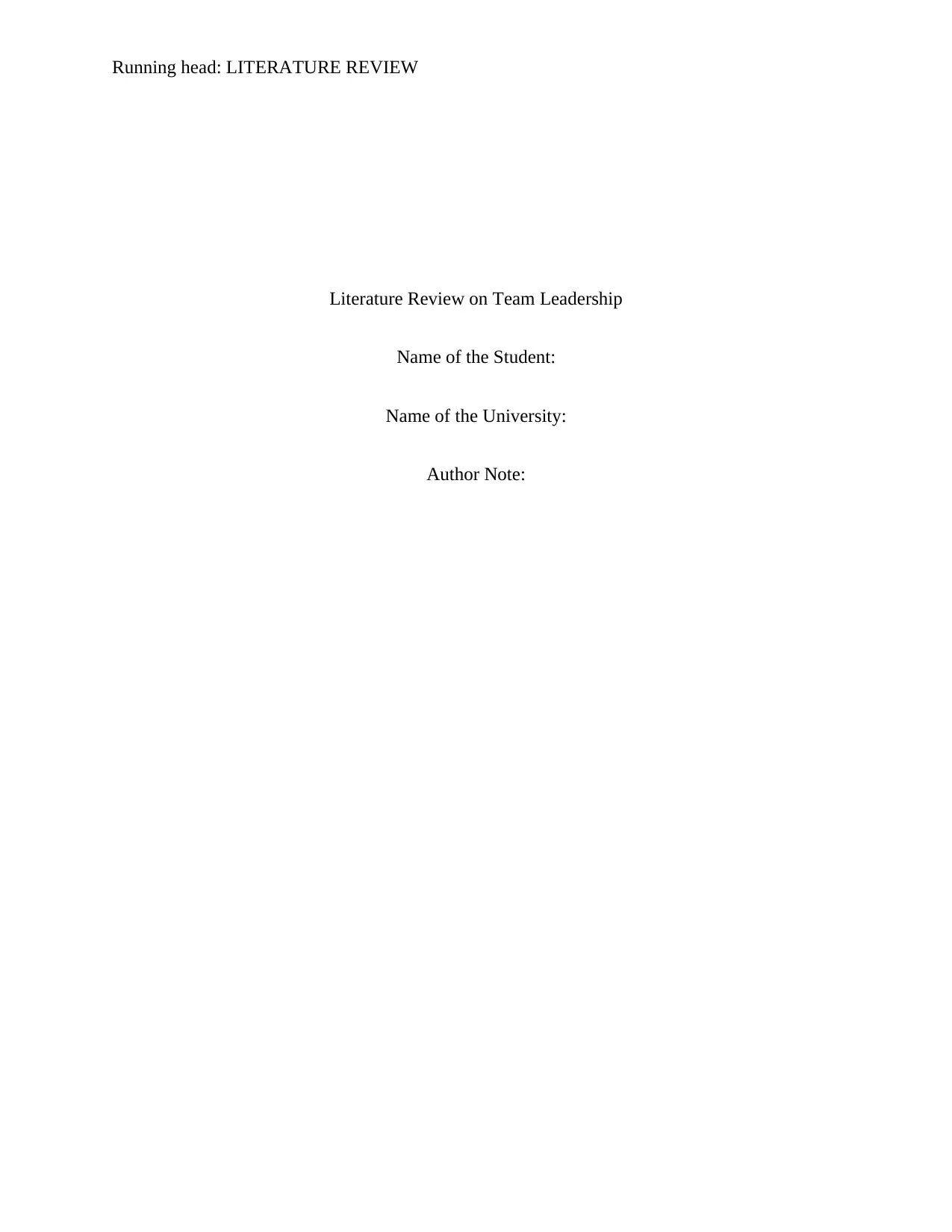
Running head: LITERATURE REVIEW
Literature Review on Team Leadership
Name of the Student:
Name of the University:
Author Note:
Literature Review on Team Leadership
Name of the Student:
Name of the University:
Author Note:
Secure Best Marks with AI Grader
Need help grading? Try our AI Grader for instant feedback on your assignments.
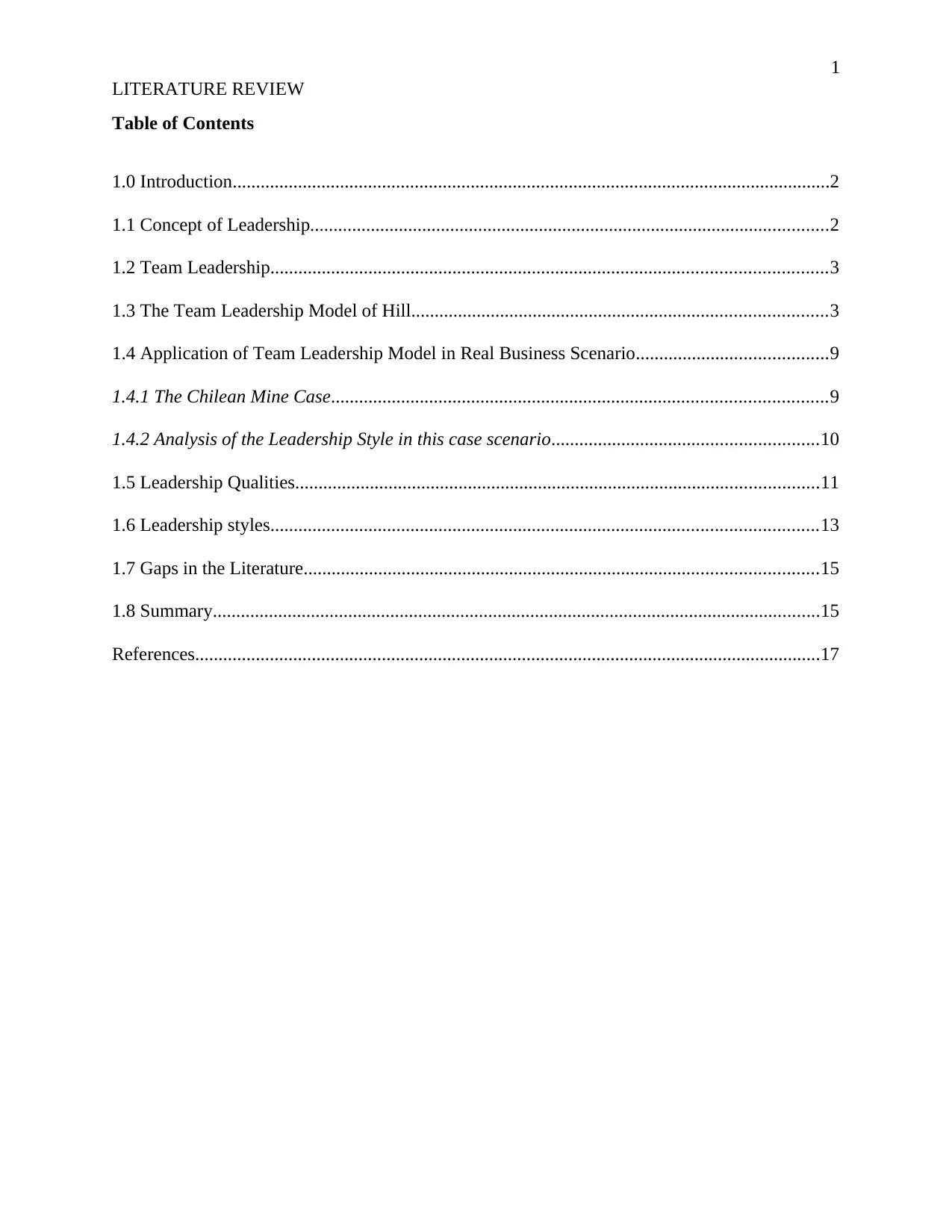
1
LITERATURE REVIEW
Table of Contents
1.0 Introduction................................................................................................................................2
1.1 Concept of Leadership...............................................................................................................2
1.2 Team Leadership.......................................................................................................................3
1.3 The Team Leadership Model of Hill.........................................................................................3
1.4 Application of Team Leadership Model in Real Business Scenario.........................................9
1.4.1 The Chilean Mine Case..........................................................................................................9
1.4.2 Analysis of the Leadership Style in this case scenario.........................................................10
1.5 Leadership Qualities................................................................................................................11
1.6 Leadership styles.....................................................................................................................13
1.7 Gaps in the Literature..............................................................................................................15
1.8 Summary..................................................................................................................................15
References......................................................................................................................................17
LITERATURE REVIEW
Table of Contents
1.0 Introduction................................................................................................................................2
1.1 Concept of Leadership...............................................................................................................2
1.2 Team Leadership.......................................................................................................................3
1.3 The Team Leadership Model of Hill.........................................................................................3
1.4 Application of Team Leadership Model in Real Business Scenario.........................................9
1.4.1 The Chilean Mine Case..........................................................................................................9
1.4.2 Analysis of the Leadership Style in this case scenario.........................................................10
1.5 Leadership Qualities................................................................................................................11
1.6 Leadership styles.....................................................................................................................13
1.7 Gaps in the Literature..............................................................................................................15
1.8 Summary..................................................................................................................................15
References......................................................................................................................................17
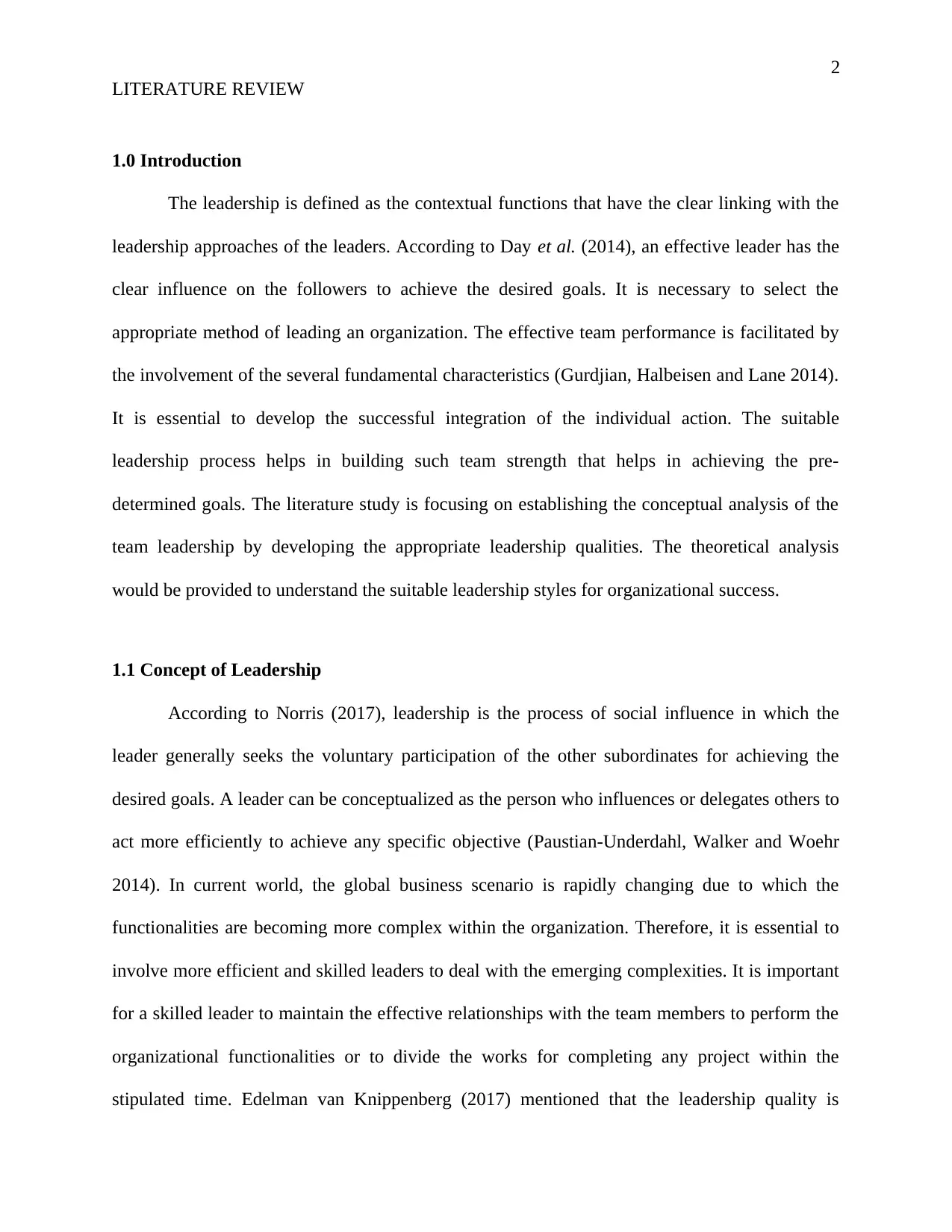
2
LITERATURE REVIEW
1.0 Introduction
The leadership is defined as the contextual functions that have the clear linking with the
leadership approaches of the leaders. According to Day et al. (2014), an effective leader has the
clear influence on the followers to achieve the desired goals. It is necessary to select the
appropriate method of leading an organization. The effective team performance is facilitated by
the involvement of the several fundamental characteristics (Gurdjian, Halbeisen and Lane 2014).
It is essential to develop the successful integration of the individual action. The suitable
leadership process helps in building such team strength that helps in achieving the pre-
determined goals. The literature study is focusing on establishing the conceptual analysis of the
team leadership by developing the appropriate leadership qualities. The theoretical analysis
would be provided to understand the suitable leadership styles for organizational success.
1.1 Concept of Leadership
According to Norris (2017), leadership is the process of social influence in which the
leader generally seeks the voluntary participation of the other subordinates for achieving the
desired goals. A leader can be conceptualized as the person who influences or delegates others to
act more efficiently to achieve any specific objective (Paustian-Underdahl, Walker and Woehr
2014). In current world, the global business scenario is rapidly changing due to which the
functionalities are becoming more complex within the organization. Therefore, it is essential to
involve more efficient and skilled leaders to deal with the emerging complexities. It is important
for a skilled leader to maintain the effective relationships with the team members to perform the
organizational functionalities or to divide the works for completing any project within the
stipulated time. Edelman van Knippenberg (2017) mentioned that the leadership quality is
LITERATURE REVIEW
1.0 Introduction
The leadership is defined as the contextual functions that have the clear linking with the
leadership approaches of the leaders. According to Day et al. (2014), an effective leader has the
clear influence on the followers to achieve the desired goals. It is necessary to select the
appropriate method of leading an organization. The effective team performance is facilitated by
the involvement of the several fundamental characteristics (Gurdjian, Halbeisen and Lane 2014).
It is essential to develop the successful integration of the individual action. The suitable
leadership process helps in building such team strength that helps in achieving the pre-
determined goals. The literature study is focusing on establishing the conceptual analysis of the
team leadership by developing the appropriate leadership qualities. The theoretical analysis
would be provided to understand the suitable leadership styles for organizational success.
1.1 Concept of Leadership
According to Norris (2017), leadership is the process of social influence in which the
leader generally seeks the voluntary participation of the other subordinates for achieving the
desired goals. A leader can be conceptualized as the person who influences or delegates others to
act more efficiently to achieve any specific objective (Paustian-Underdahl, Walker and Woehr
2014). In current world, the global business scenario is rapidly changing due to which the
functionalities are becoming more complex within the organization. Therefore, it is essential to
involve more efficient and skilled leaders to deal with the emerging complexities. It is important
for a skilled leader to maintain the effective relationships with the team members to perform the
organizational functionalities or to divide the works for completing any project within the
stipulated time. Edelman van Knippenberg (2017) mentioned that the leadership quality is
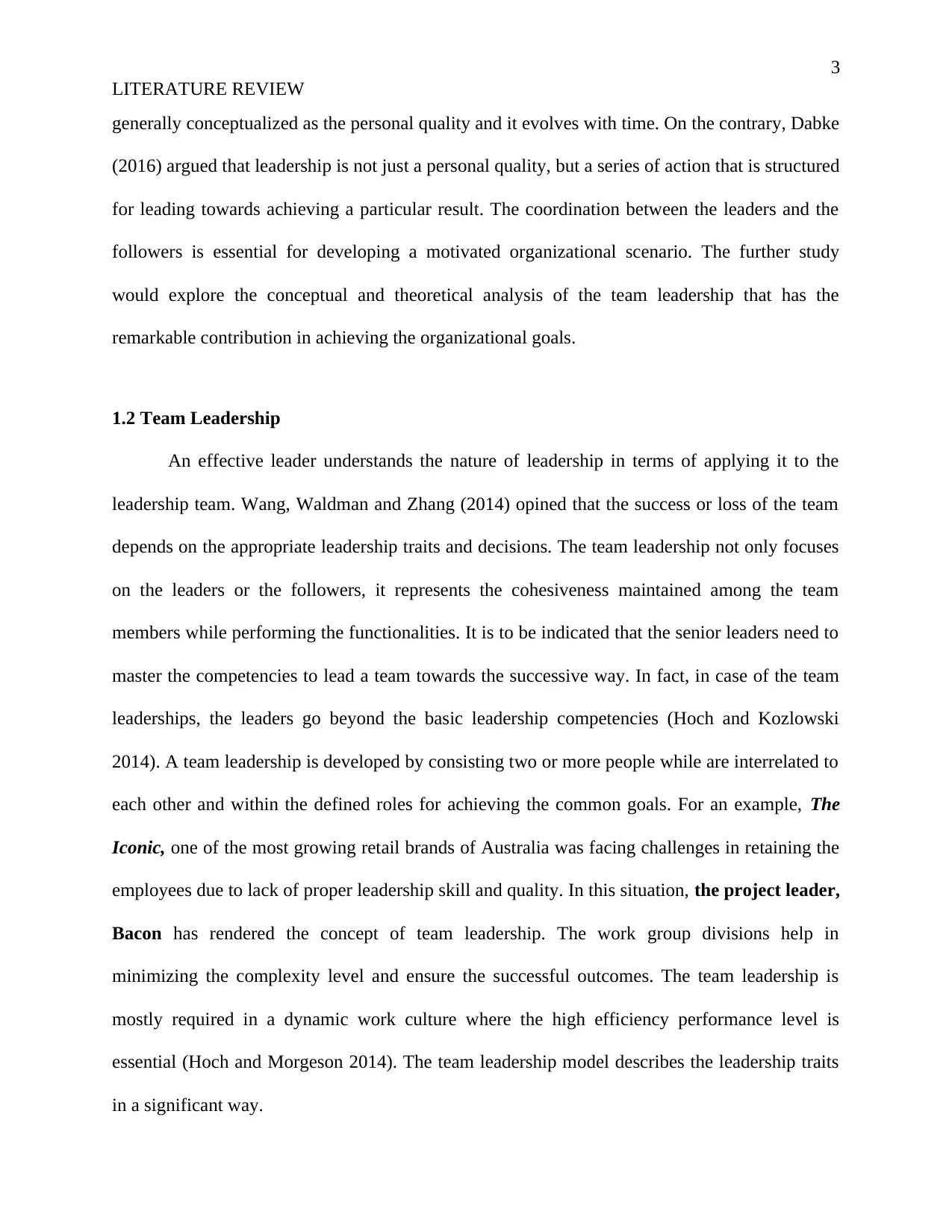
3
LITERATURE REVIEW
generally conceptualized as the personal quality and it evolves with time. On the contrary, Dabke
(2016) argued that leadership is not just a personal quality, but a series of action that is structured
for leading towards achieving a particular result. The coordination between the leaders and the
followers is essential for developing a motivated organizational scenario. The further study
would explore the conceptual and theoretical analysis of the team leadership that has the
remarkable contribution in achieving the organizational goals.
1.2 Team Leadership
An effective leader understands the nature of leadership in terms of applying it to the
leadership team. Wang, Waldman and Zhang (2014) opined that the success or loss of the team
depends on the appropriate leadership traits and decisions. The team leadership not only focuses
on the leaders or the followers, it represents the cohesiveness maintained among the team
members while performing the functionalities. It is to be indicated that the senior leaders need to
master the competencies to lead a team towards the successive way. In fact, in case of the team
leaderships, the leaders go beyond the basic leadership competencies (Hoch and Kozlowski
2014). A team leadership is developed by consisting two or more people while are interrelated to
each other and within the defined roles for achieving the common goals. For an example, The
Iconic, one of the most growing retail brands of Australia was facing challenges in retaining the
employees due to lack of proper leadership skill and quality. In this situation, the project leader,
Bacon has rendered the concept of team leadership. The work group divisions help in
minimizing the complexity level and ensure the successful outcomes. The team leadership is
mostly required in a dynamic work culture where the high efficiency performance level is
essential (Hoch and Morgeson 2014). The team leadership model describes the leadership traits
in a significant way.
LITERATURE REVIEW
generally conceptualized as the personal quality and it evolves with time. On the contrary, Dabke
(2016) argued that leadership is not just a personal quality, but a series of action that is structured
for leading towards achieving a particular result. The coordination between the leaders and the
followers is essential for developing a motivated organizational scenario. The further study
would explore the conceptual and theoretical analysis of the team leadership that has the
remarkable contribution in achieving the organizational goals.
1.2 Team Leadership
An effective leader understands the nature of leadership in terms of applying it to the
leadership team. Wang, Waldman and Zhang (2014) opined that the success or loss of the team
depends on the appropriate leadership traits and decisions. The team leadership not only focuses
on the leaders or the followers, it represents the cohesiveness maintained among the team
members while performing the functionalities. It is to be indicated that the senior leaders need to
master the competencies to lead a team towards the successive way. In fact, in case of the team
leaderships, the leaders go beyond the basic leadership competencies (Hoch and Kozlowski
2014). A team leadership is developed by consisting two or more people while are interrelated to
each other and within the defined roles for achieving the common goals. For an example, The
Iconic, one of the most growing retail brands of Australia was facing challenges in retaining the
employees due to lack of proper leadership skill and quality. In this situation, the project leader,
Bacon has rendered the concept of team leadership. The work group divisions help in
minimizing the complexity level and ensure the successful outcomes. The team leadership is
mostly required in a dynamic work culture where the high efficiency performance level is
essential (Hoch and Morgeson 2014). The team leadership model describes the leadership traits
in a significant way.
Paraphrase This Document
Need a fresh take? Get an instant paraphrase of this document with our AI Paraphraser
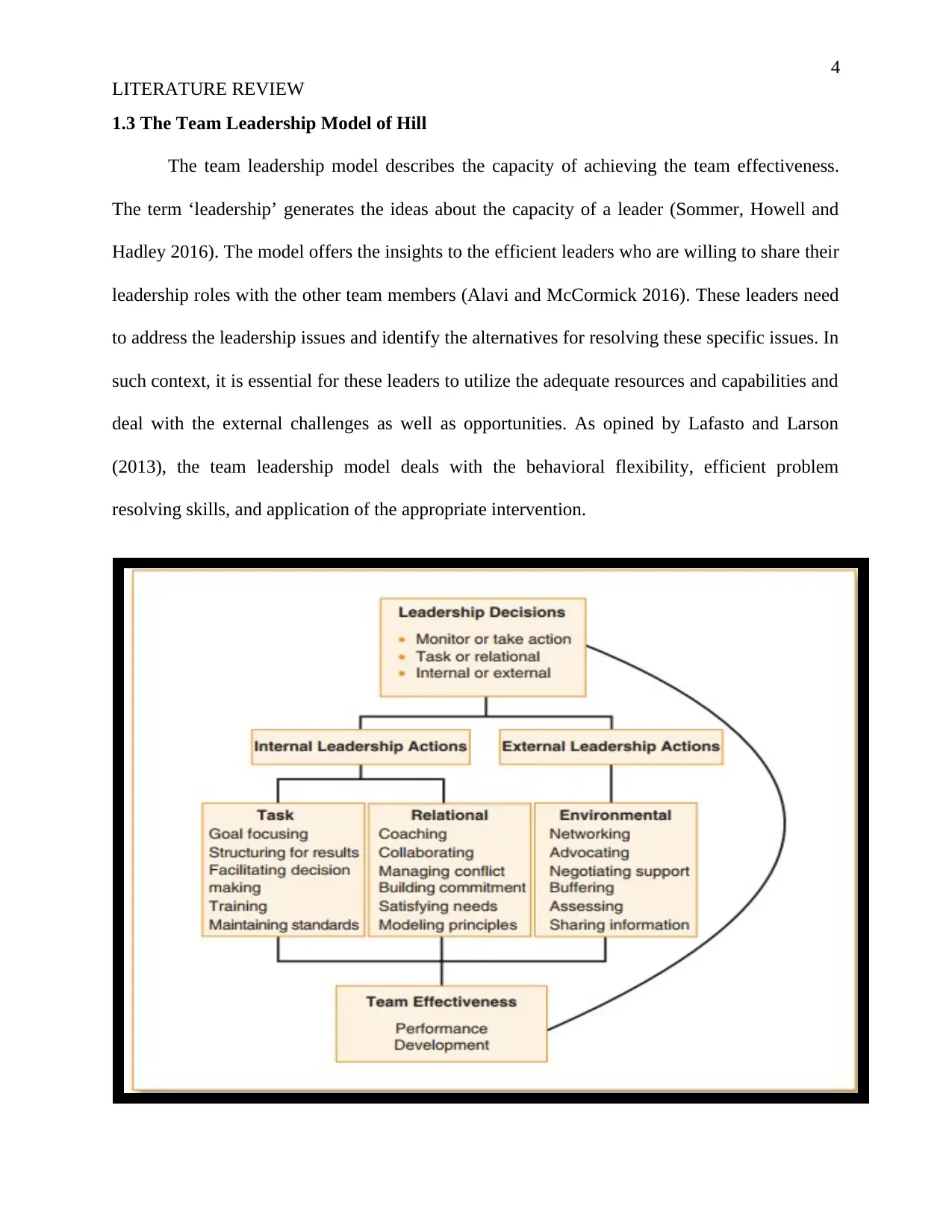
4
LITERATURE REVIEW
1.3 The Team Leadership Model of Hill
The team leadership model describes the capacity of achieving the team effectiveness.
The term ‘leadership’ generates the ideas about the capacity of a leader (Sommer, Howell and
Hadley 2016). The model offers the insights to the efficient leaders who are willing to share their
leadership roles with the other team members (Alavi and McCormick 2016). These leaders need
to address the leadership issues and identify the alternatives for resolving these specific issues. In
such context, it is essential for these leaders to utilize the adequate resources and capabilities and
deal with the external challenges as well as opportunities. As opined by Lafasto and Larson
(2013), the team leadership model deals with the behavioral flexibility, efficient problem
resolving skills, and application of the appropriate intervention.
LITERATURE REVIEW
1.3 The Team Leadership Model of Hill
The team leadership model describes the capacity of achieving the team effectiveness.
The term ‘leadership’ generates the ideas about the capacity of a leader (Sommer, Howell and
Hadley 2016). The model offers the insights to the efficient leaders who are willing to share their
leadership roles with the other team members (Alavi and McCormick 2016). These leaders need
to address the leadership issues and identify the alternatives for resolving these specific issues. In
such context, it is essential for these leaders to utilize the adequate resources and capabilities and
deal with the external challenges as well as opportunities. As opined by Lafasto and Larson
(2013), the team leadership model deals with the behavioral flexibility, efficient problem
resolving skills, and application of the appropriate intervention.
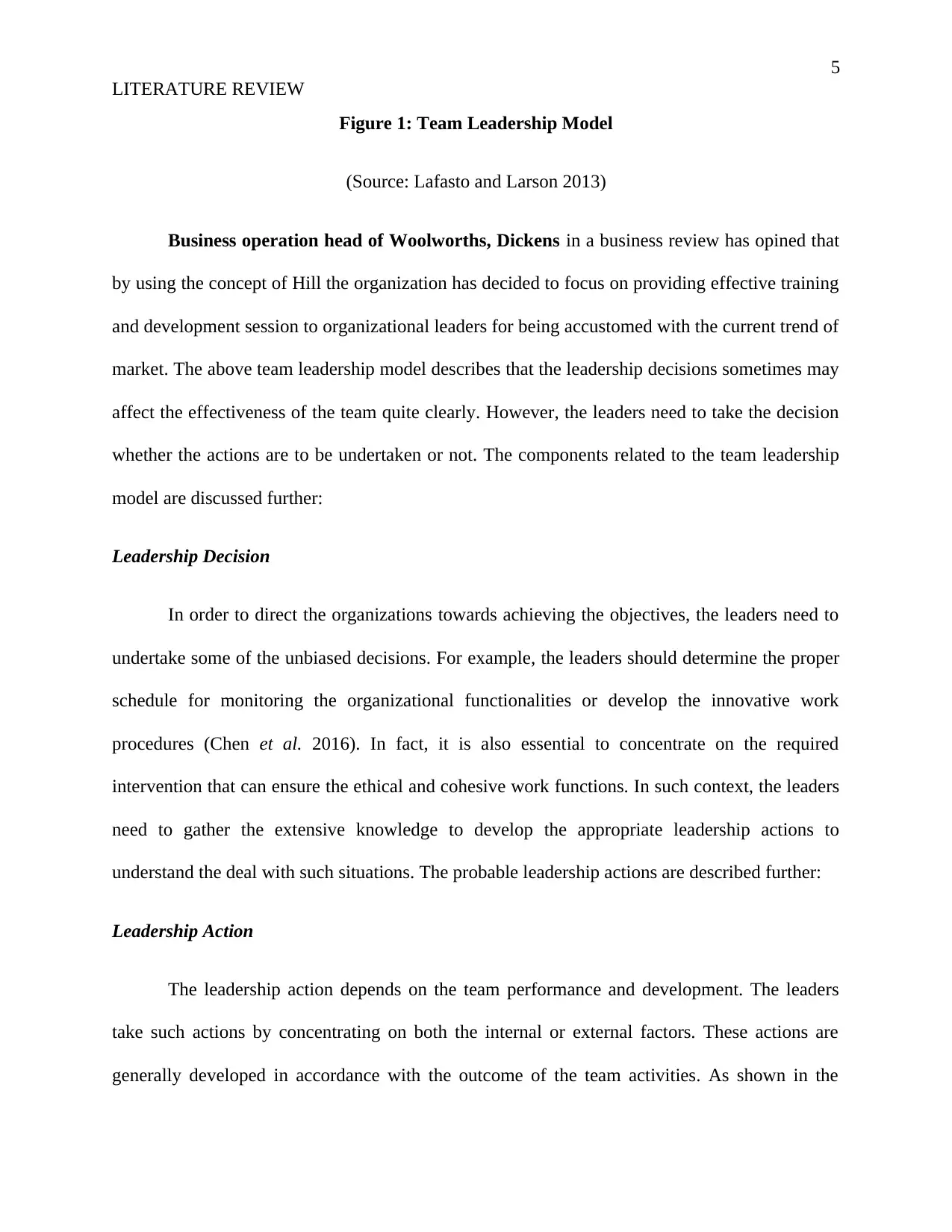
5
LITERATURE REVIEW
Figure 1: Team Leadership Model
(Source: Lafasto and Larson 2013)
Business operation head of Woolworths, Dickens in a business review has opined that
by using the concept of Hill the organization has decided to focus on providing effective training
and development session to organizational leaders for being accustomed with the current trend of
market. The above team leadership model describes that the leadership decisions sometimes may
affect the effectiveness of the team quite clearly. However, the leaders need to take the decision
whether the actions are to be undertaken or not. The components related to the team leadership
model are discussed further:
Leadership Decision
In order to direct the organizations towards achieving the objectives, the leaders need to
undertake some of the unbiased decisions. For example, the leaders should determine the proper
schedule for monitoring the organizational functionalities or develop the innovative work
procedures (Chen et al. 2016). In fact, it is also essential to concentrate on the required
intervention that can ensure the ethical and cohesive work functions. In such context, the leaders
need to gather the extensive knowledge to develop the appropriate leadership actions to
understand the deal with such situations. The probable leadership actions are described further:
Leadership Action
The leadership action depends on the team performance and development. The leaders
take such actions by concentrating on both the internal or external factors. These actions are
generally developed in accordance with the outcome of the team activities. As shown in the
LITERATURE REVIEW
Figure 1: Team Leadership Model
(Source: Lafasto and Larson 2013)
Business operation head of Woolworths, Dickens in a business review has opined that
by using the concept of Hill the organization has decided to focus on providing effective training
and development session to organizational leaders for being accustomed with the current trend of
market. The above team leadership model describes that the leadership decisions sometimes may
affect the effectiveness of the team quite clearly. However, the leaders need to take the decision
whether the actions are to be undertaken or not. The components related to the team leadership
model are discussed further:
Leadership Decision
In order to direct the organizations towards achieving the objectives, the leaders need to
undertake some of the unbiased decisions. For example, the leaders should determine the proper
schedule for monitoring the organizational functionalities or develop the innovative work
procedures (Chen et al. 2016). In fact, it is also essential to concentrate on the required
intervention that can ensure the ethical and cohesive work functions. In such context, the leaders
need to gather the extensive knowledge to develop the appropriate leadership actions to
understand the deal with such situations. The probable leadership actions are described further:
Leadership Action
The leadership action depends on the team performance and development. The leaders
take such actions by concentrating on both the internal or external factors. These actions are
generally developed in accordance with the outcome of the team activities. As shown in the
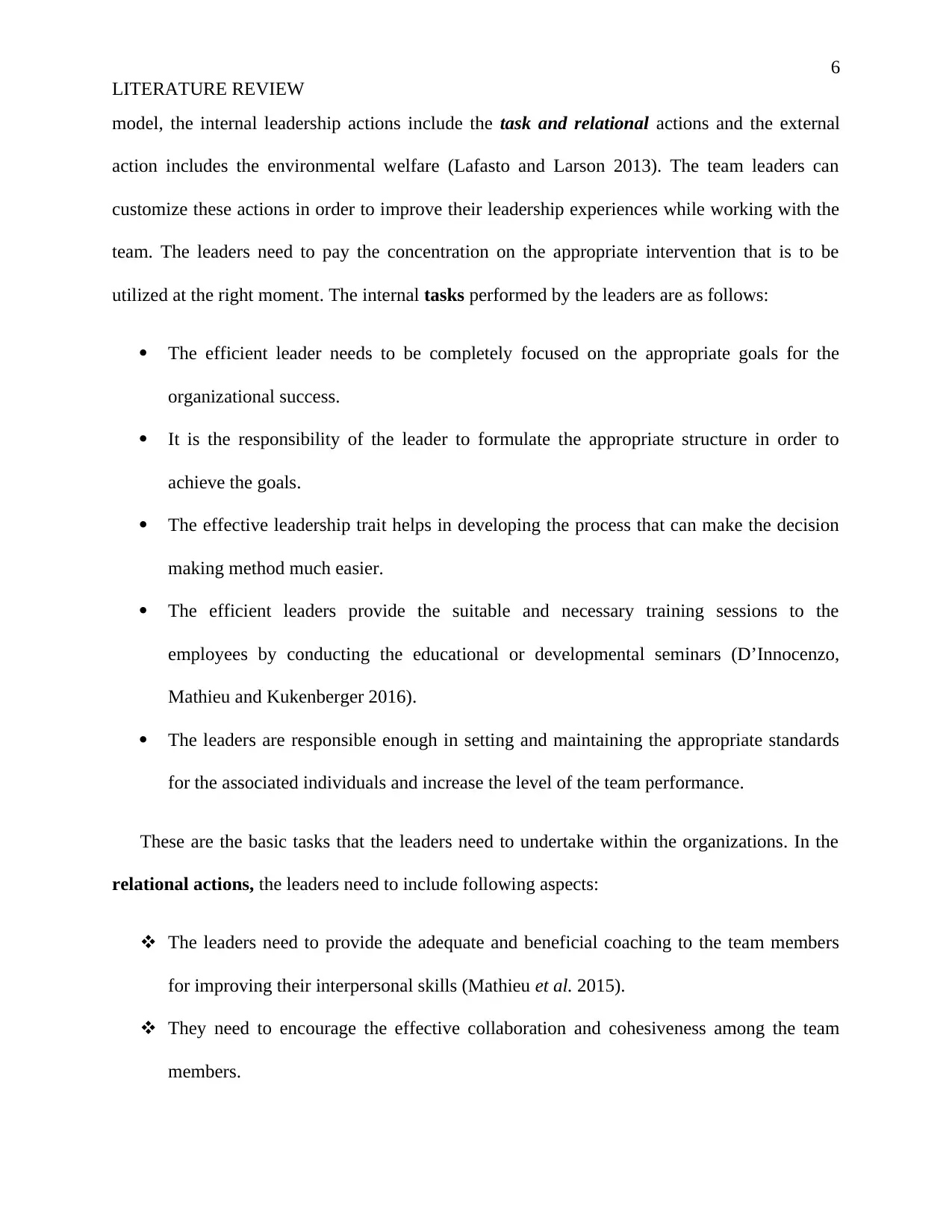
6
LITERATURE REVIEW
model, the internal leadership actions include the task and relational actions and the external
action includes the environmental welfare (Lafasto and Larson 2013). The team leaders can
customize these actions in order to improve their leadership experiences while working with the
team. The leaders need to pay the concentration on the appropriate intervention that is to be
utilized at the right moment. The internal tasks performed by the leaders are as follows:
The efficient leader needs to be completely focused on the appropriate goals for the
organizational success.
It is the responsibility of the leader to formulate the appropriate structure in order to
achieve the goals.
The effective leadership trait helps in developing the process that can make the decision
making method much easier.
The efficient leaders provide the suitable and necessary training sessions to the
employees by conducting the educational or developmental seminars (D’Innocenzo,
Mathieu and Kukenberger 2016).
The leaders are responsible enough in setting and maintaining the appropriate standards
for the associated individuals and increase the level of the team performance.
These are the basic tasks that the leaders need to undertake within the organizations. In the
relational actions, the leaders need to include following aspects:
The leaders need to provide the adequate and beneficial coaching to the team members
for improving their interpersonal skills (Mathieu et al. 2015).
They need to encourage the effective collaboration and cohesiveness among the team
members.
LITERATURE REVIEW
model, the internal leadership actions include the task and relational actions and the external
action includes the environmental welfare (Lafasto and Larson 2013). The team leaders can
customize these actions in order to improve their leadership experiences while working with the
team. The leaders need to pay the concentration on the appropriate intervention that is to be
utilized at the right moment. The internal tasks performed by the leaders are as follows:
The efficient leader needs to be completely focused on the appropriate goals for the
organizational success.
It is the responsibility of the leader to formulate the appropriate structure in order to
achieve the goals.
The effective leadership trait helps in developing the process that can make the decision
making method much easier.
The efficient leaders provide the suitable and necessary training sessions to the
employees by conducting the educational or developmental seminars (D’Innocenzo,
Mathieu and Kukenberger 2016).
The leaders are responsible enough in setting and maintaining the appropriate standards
for the associated individuals and increase the level of the team performance.
These are the basic tasks that the leaders need to undertake within the organizations. In the
relational actions, the leaders need to include following aspects:
The leaders need to provide the adequate and beneficial coaching to the team members
for improving their interpersonal skills (Mathieu et al. 2015).
They need to encourage the effective collaboration and cohesiveness among the team
members.
Secure Best Marks with AI Grader
Need help grading? Try our AI Grader for instant feedback on your assignments.

7
LITERATURE REVIEW
They need to manage the conflict for allowing the intellectual conflicts and resolve the
personal conflicts. The emergence of the intellectual conflicts helps in developing the
innovative procedures of performing the organizational functionalities.
It is essential for the efficient leaders to enhance the team commitments.
The efficient leaders need to always concentrate on satisfying the supports and trust that
are necessary for the team members (Sommer, Howell and Hadley 2016).
A skilled leader needs to maintain the ethical parameter at the first place and need to be
fair and consistent. This consistency would help the leaders to exercise the principled
behavior.
These specific responsibilities are needed to be maintained by the efficient leader within
an organization. Maintaining these internal responsibilities would be fruitful enough in leading
towards achieving the pre-determined goals. Moreover, the associated employees will also gain
the trust on their leaders to move ahead and achieve both the personal and professional goals.
Apart from these internal actions, the leaders need to be much focused on some of the
specific external actions as well. Certo (2015) defined that the external leadership actions
contribute to protect the team from the external environment and keeping the team connected to
the external environment simultaneously. The following practices are necessary for the leaders to
develop the remarkable external actions:
It is necessary for the leaders to establish the effective networking for developing the
alliances and gain the proper access to the necessary information.
The efficient leaders advocate for the team with those who create the negative impacts on
environment.
LITERATURE REVIEW
They need to manage the conflict for allowing the intellectual conflicts and resolve the
personal conflicts. The emergence of the intellectual conflicts helps in developing the
innovative procedures of performing the organizational functionalities.
It is essential for the efficient leaders to enhance the team commitments.
The efficient leaders need to always concentrate on satisfying the supports and trust that
are necessary for the team members (Sommer, Howell and Hadley 2016).
A skilled leader needs to maintain the ethical parameter at the first place and need to be
fair and consistent. This consistency would help the leaders to exercise the principled
behavior.
These specific responsibilities are needed to be maintained by the efficient leader within
an organization. Maintaining these internal responsibilities would be fruitful enough in leading
towards achieving the pre-determined goals. Moreover, the associated employees will also gain
the trust on their leaders to move ahead and achieve both the personal and professional goals.
Apart from these internal actions, the leaders need to be much focused on some of the
specific external actions as well. Certo (2015) defined that the external leadership actions
contribute to protect the team from the external environment and keeping the team connected to
the external environment simultaneously. The following practices are necessary for the leaders to
develop the remarkable external actions:
It is necessary for the leaders to establish the effective networking for developing the
alliances and gain the proper access to the necessary information.
The efficient leaders advocate for the team with those who create the negative impacts on
environment.
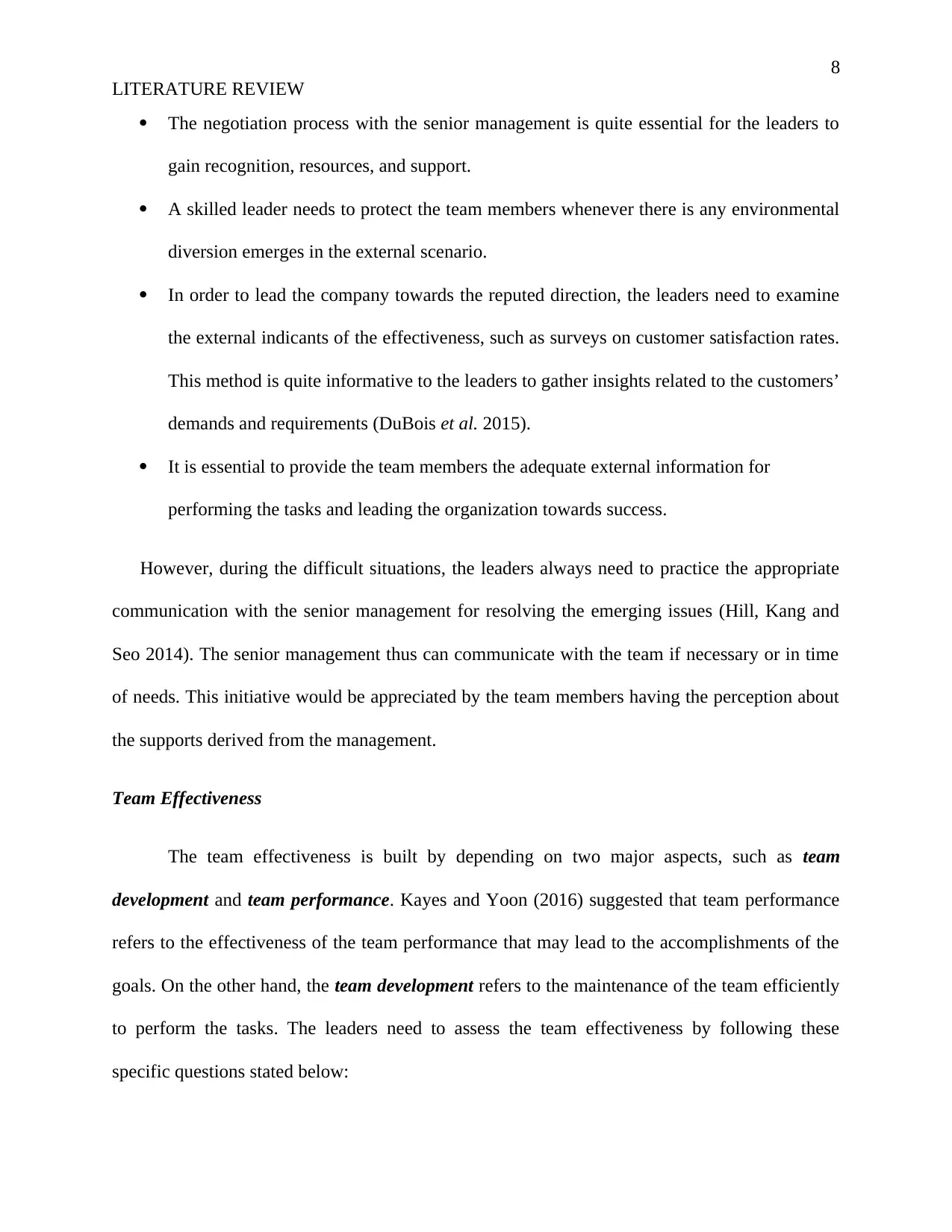
8
LITERATURE REVIEW
The negotiation process with the senior management is quite essential for the leaders to
gain recognition, resources, and support.
A skilled leader needs to protect the team members whenever there is any environmental
diversion emerges in the external scenario.
In order to lead the company towards the reputed direction, the leaders need to examine
the external indicants of the effectiveness, such as surveys on customer satisfaction rates.
This method is quite informative to the leaders to gather insights related to the customers’
demands and requirements (DuBois et al. 2015).
It is essential to provide the team members the adequate external information for
performing the tasks and leading the organization towards success.
However, during the difficult situations, the leaders always need to practice the appropriate
communication with the senior management for resolving the emerging issues (Hill, Kang and
Seo 2014). The senior management thus can communicate with the team if necessary or in time
of needs. This initiative would be appreciated by the team members having the perception about
the supports derived from the management.
Team Effectiveness
The team effectiveness is built by depending on two major aspects, such as team
development and team performance. Kayes and Yoon (2016) suggested that team performance
refers to the effectiveness of the team performance that may lead to the accomplishments of the
goals. On the other hand, the team development refers to the maintenance of the team efficiently
to perform the tasks. The leaders need to assess the team effectiveness by following these
specific questions stated below:
LITERATURE REVIEW
The negotiation process with the senior management is quite essential for the leaders to
gain recognition, resources, and support.
A skilled leader needs to protect the team members whenever there is any environmental
diversion emerges in the external scenario.
In order to lead the company towards the reputed direction, the leaders need to examine
the external indicants of the effectiveness, such as surveys on customer satisfaction rates.
This method is quite informative to the leaders to gather insights related to the customers’
demands and requirements (DuBois et al. 2015).
It is essential to provide the team members the adequate external information for
performing the tasks and leading the organization towards success.
However, during the difficult situations, the leaders always need to practice the appropriate
communication with the senior management for resolving the emerging issues (Hill, Kang and
Seo 2014). The senior management thus can communicate with the team if necessary or in time
of needs. This initiative would be appreciated by the team members having the perception about
the supports derived from the management.
Team Effectiveness
The team effectiveness is built by depending on two major aspects, such as team
development and team performance. Kayes and Yoon (2016) suggested that team performance
refers to the effectiveness of the team performance that may lead to the accomplishments of the
goals. On the other hand, the team development refers to the maintenance of the team efficiently
to perform the tasks. The leaders need to assess the team effectiveness by following these
specific questions stated below:
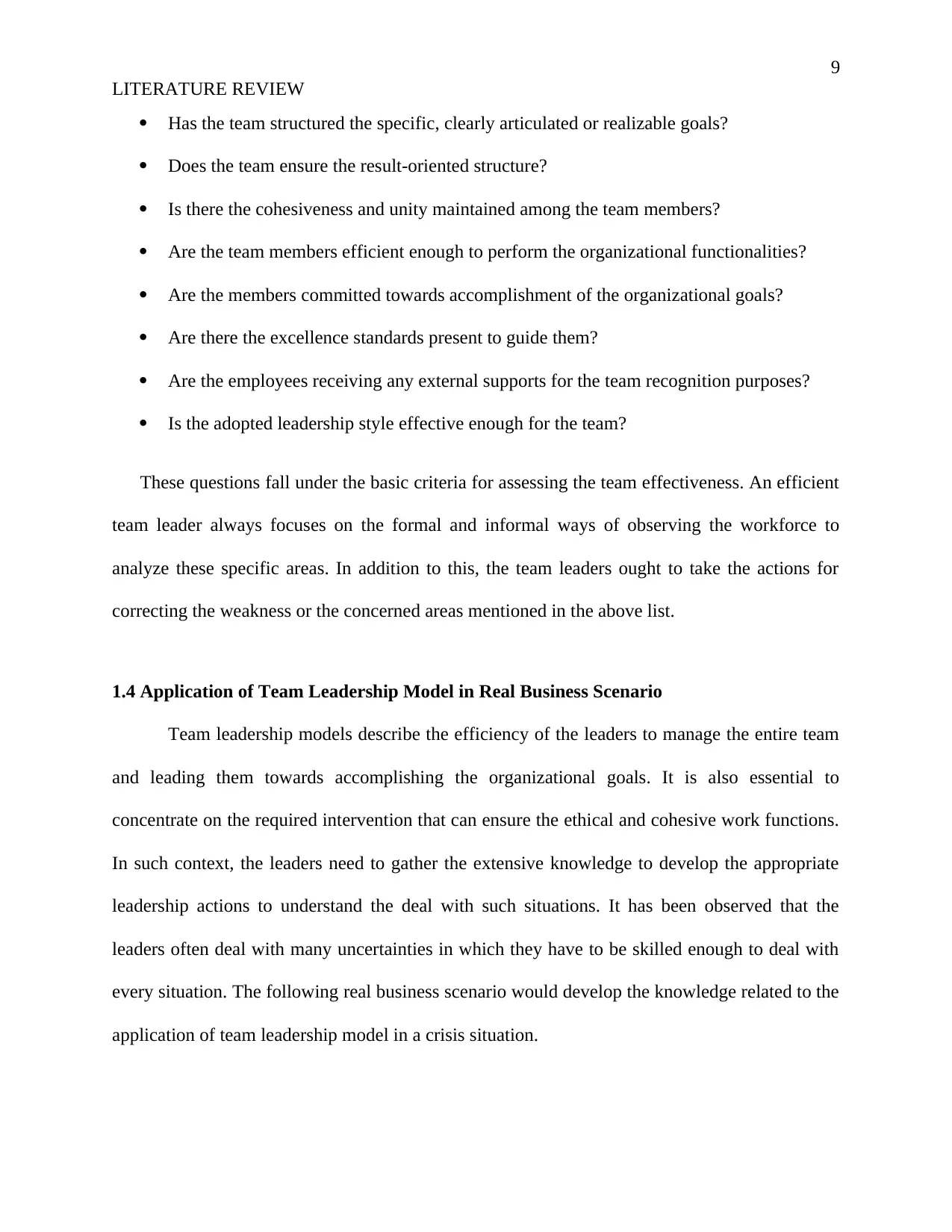
9
LITERATURE REVIEW
Has the team structured the specific, clearly articulated or realizable goals?
Does the team ensure the result-oriented structure?
Is there the cohesiveness and unity maintained among the team members?
Are the team members efficient enough to perform the organizational functionalities?
Are the members committed towards accomplishment of the organizational goals?
Are there the excellence standards present to guide them?
Are the employees receiving any external supports for the team recognition purposes?
Is the adopted leadership style effective enough for the team?
These questions fall under the basic criteria for assessing the team effectiveness. An efficient
team leader always focuses on the formal and informal ways of observing the workforce to
analyze these specific areas. In addition to this, the team leaders ought to take the actions for
correcting the weakness or the concerned areas mentioned in the above list.
1.4 Application of Team Leadership Model in Real Business Scenario
Team leadership models describe the efficiency of the leaders to manage the entire team
and leading them towards accomplishing the organizational goals. It is also essential to
concentrate on the required intervention that can ensure the ethical and cohesive work functions.
In such context, the leaders need to gather the extensive knowledge to develop the appropriate
leadership actions to understand the deal with such situations. It has been observed that the
leaders often deal with many uncertainties in which they have to be skilled enough to deal with
every situation. The following real business scenario would develop the knowledge related to the
application of team leadership model in a crisis situation.
LITERATURE REVIEW
Has the team structured the specific, clearly articulated or realizable goals?
Does the team ensure the result-oriented structure?
Is there the cohesiveness and unity maintained among the team members?
Are the team members efficient enough to perform the organizational functionalities?
Are the members committed towards accomplishment of the organizational goals?
Are there the excellence standards present to guide them?
Are the employees receiving any external supports for the team recognition purposes?
Is the adopted leadership style effective enough for the team?
These questions fall under the basic criteria for assessing the team effectiveness. An efficient
team leader always focuses on the formal and informal ways of observing the workforce to
analyze these specific areas. In addition to this, the team leaders ought to take the actions for
correcting the weakness or the concerned areas mentioned in the above list.
1.4 Application of Team Leadership Model in Real Business Scenario
Team leadership models describe the efficiency of the leaders to manage the entire team
and leading them towards accomplishing the organizational goals. It is also essential to
concentrate on the required intervention that can ensure the ethical and cohesive work functions.
In such context, the leaders need to gather the extensive knowledge to develop the appropriate
leadership actions to understand the deal with such situations. It has been observed that the
leaders often deal with many uncertainties in which they have to be skilled enough to deal with
every situation. The following real business scenario would develop the knowledge related to the
application of team leadership model in a crisis situation.
Paraphrase This Document
Need a fresh take? Get an instant paraphrase of this document with our AI Paraphraser
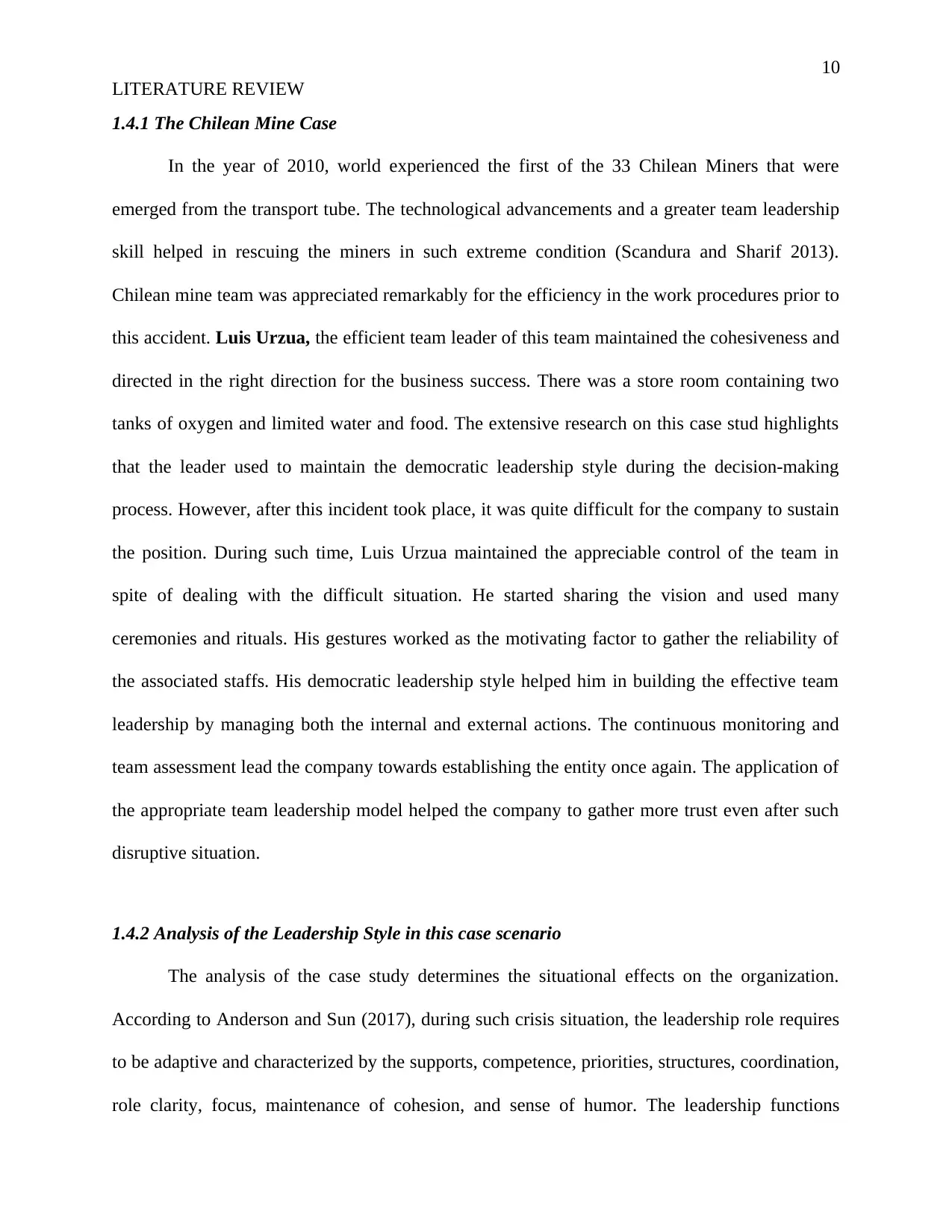
10
LITERATURE REVIEW
1.4.1 The Chilean Mine Case
In the year of 2010, world experienced the first of the 33 Chilean Miners that were
emerged from the transport tube. The technological advancements and a greater team leadership
skill helped in rescuing the miners in such extreme condition (Scandura and Sharif 2013).
Chilean mine team was appreciated remarkably for the efficiency in the work procedures prior to
this accident. Luis Urzua, the efficient team leader of this team maintained the cohesiveness and
directed in the right direction for the business success. There was a store room containing two
tanks of oxygen and limited water and food. The extensive research on this case stud highlights
that the leader used to maintain the democratic leadership style during the decision-making
process. However, after this incident took place, it was quite difficult for the company to sustain
the position. During such time, Luis Urzua maintained the appreciable control of the team in
spite of dealing with the difficult situation. He started sharing the vision and used many
ceremonies and rituals. His gestures worked as the motivating factor to gather the reliability of
the associated staffs. His democratic leadership style helped him in building the effective team
leadership by managing both the internal and external actions. The continuous monitoring and
team assessment lead the company towards establishing the entity once again. The application of
the appropriate team leadership model helped the company to gather more trust even after such
disruptive situation.
1.4.2 Analysis of the Leadership Style in this case scenario
The analysis of the case study determines the situational effects on the organization.
According to Anderson and Sun (2017), during such crisis situation, the leadership role requires
to be adaptive and characterized by the supports, competence, priorities, structures, coordination,
role clarity, focus, maintenance of cohesion, and sense of humor. The leadership functions
LITERATURE REVIEW
1.4.1 The Chilean Mine Case
In the year of 2010, world experienced the first of the 33 Chilean Miners that were
emerged from the transport tube. The technological advancements and a greater team leadership
skill helped in rescuing the miners in such extreme condition (Scandura and Sharif 2013).
Chilean mine team was appreciated remarkably for the efficiency in the work procedures prior to
this accident. Luis Urzua, the efficient team leader of this team maintained the cohesiveness and
directed in the right direction for the business success. There was a store room containing two
tanks of oxygen and limited water and food. The extensive research on this case stud highlights
that the leader used to maintain the democratic leadership style during the decision-making
process. However, after this incident took place, it was quite difficult for the company to sustain
the position. During such time, Luis Urzua maintained the appreciable control of the team in
spite of dealing with the difficult situation. He started sharing the vision and used many
ceremonies and rituals. His gestures worked as the motivating factor to gather the reliability of
the associated staffs. His democratic leadership style helped him in building the effective team
leadership by managing both the internal and external actions. The continuous monitoring and
team assessment lead the company towards establishing the entity once again. The application of
the appropriate team leadership model helped the company to gather more trust even after such
disruptive situation.
1.4.2 Analysis of the Leadership Style in this case scenario
The analysis of the case study determines the situational effects on the organization.
According to Anderson and Sun (2017), during such crisis situation, the leadership role requires
to be adaptive and characterized by the supports, competence, priorities, structures, coordination,
role clarity, focus, maintenance of cohesion, and sense of humor. The leadership functions
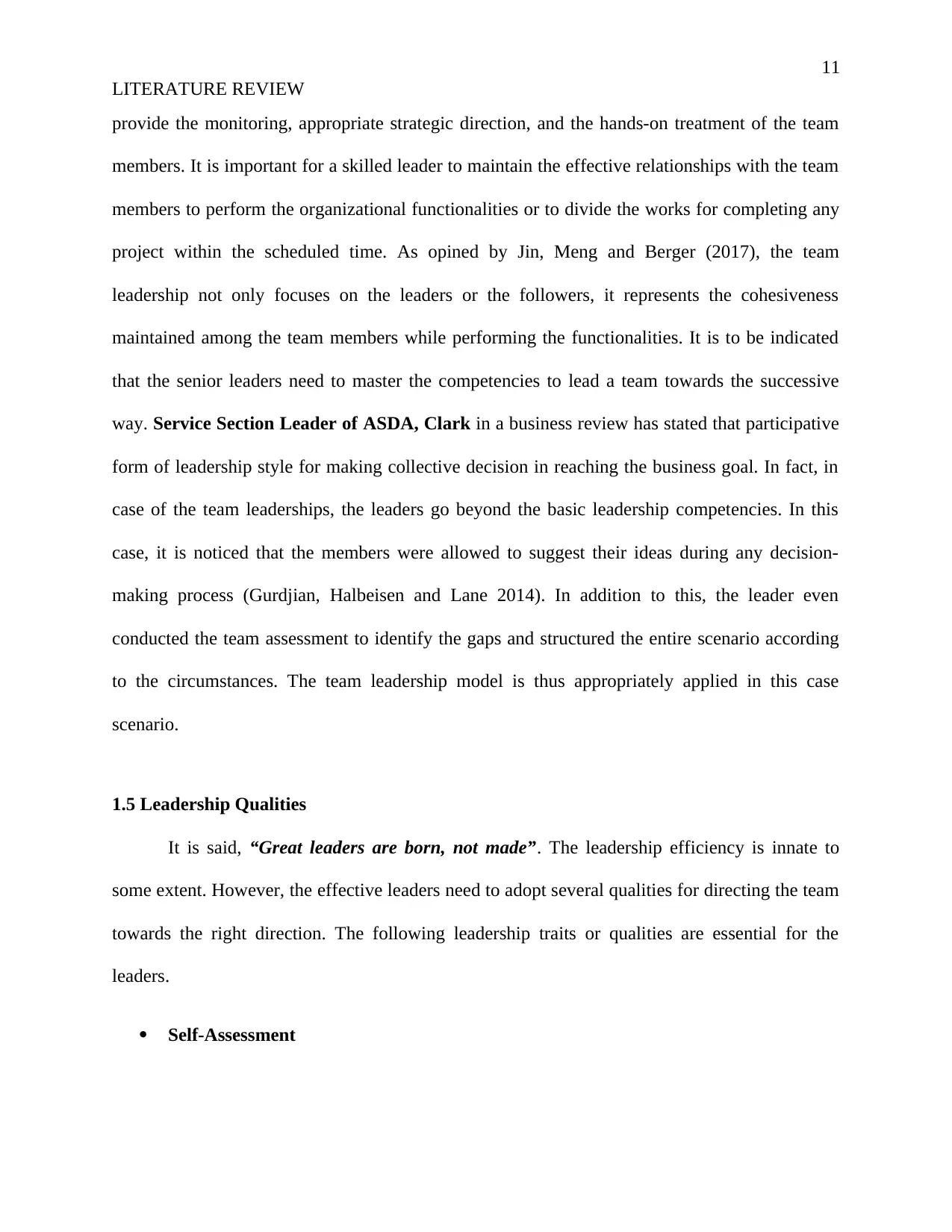
11
LITERATURE REVIEW
provide the monitoring, appropriate strategic direction, and the hands-on treatment of the team
members. It is important for a skilled leader to maintain the effective relationships with the team
members to perform the organizational functionalities or to divide the works for completing any
project within the scheduled time. As opined by Jin, Meng and Berger (2017), the team
leadership not only focuses on the leaders or the followers, it represents the cohesiveness
maintained among the team members while performing the functionalities. It is to be indicated
that the senior leaders need to master the competencies to lead a team towards the successive
way. Service Section Leader of ASDA, Clark in a business review has stated that participative
form of leadership style for making collective decision in reaching the business goal. In fact, in
case of the team leaderships, the leaders go beyond the basic leadership competencies. In this
case, it is noticed that the members were allowed to suggest their ideas during any decision-
making process (Gurdjian, Halbeisen and Lane 2014). In addition to this, the leader even
conducted the team assessment to identify the gaps and structured the entire scenario according
to the circumstances. The team leadership model is thus appropriately applied in this case
scenario.
1.5 Leadership Qualities
It is said, “Great leaders are born, not made”. The leadership efficiency is innate to
some extent. However, the effective leaders need to adopt several qualities for directing the team
towards the right direction. The following leadership traits or qualities are essential for the
leaders.
Self-Assessment
LITERATURE REVIEW
provide the monitoring, appropriate strategic direction, and the hands-on treatment of the team
members. It is important for a skilled leader to maintain the effective relationships with the team
members to perform the organizational functionalities or to divide the works for completing any
project within the scheduled time. As opined by Jin, Meng and Berger (2017), the team
leadership not only focuses on the leaders or the followers, it represents the cohesiveness
maintained among the team members while performing the functionalities. It is to be indicated
that the senior leaders need to master the competencies to lead a team towards the successive
way. Service Section Leader of ASDA, Clark in a business review has stated that participative
form of leadership style for making collective decision in reaching the business goal. In fact, in
case of the team leaderships, the leaders go beyond the basic leadership competencies. In this
case, it is noticed that the members were allowed to suggest their ideas during any decision-
making process (Gurdjian, Halbeisen and Lane 2014). In addition to this, the leader even
conducted the team assessment to identify the gaps and structured the entire scenario according
to the circumstances. The team leadership model is thus appropriately applied in this case
scenario.
1.5 Leadership Qualities
It is said, “Great leaders are born, not made”. The leadership efficiency is innate to
some extent. However, the effective leaders need to adopt several qualities for directing the team
towards the right direction. The following leadership traits or qualities are essential for the
leaders.
Self-Assessment
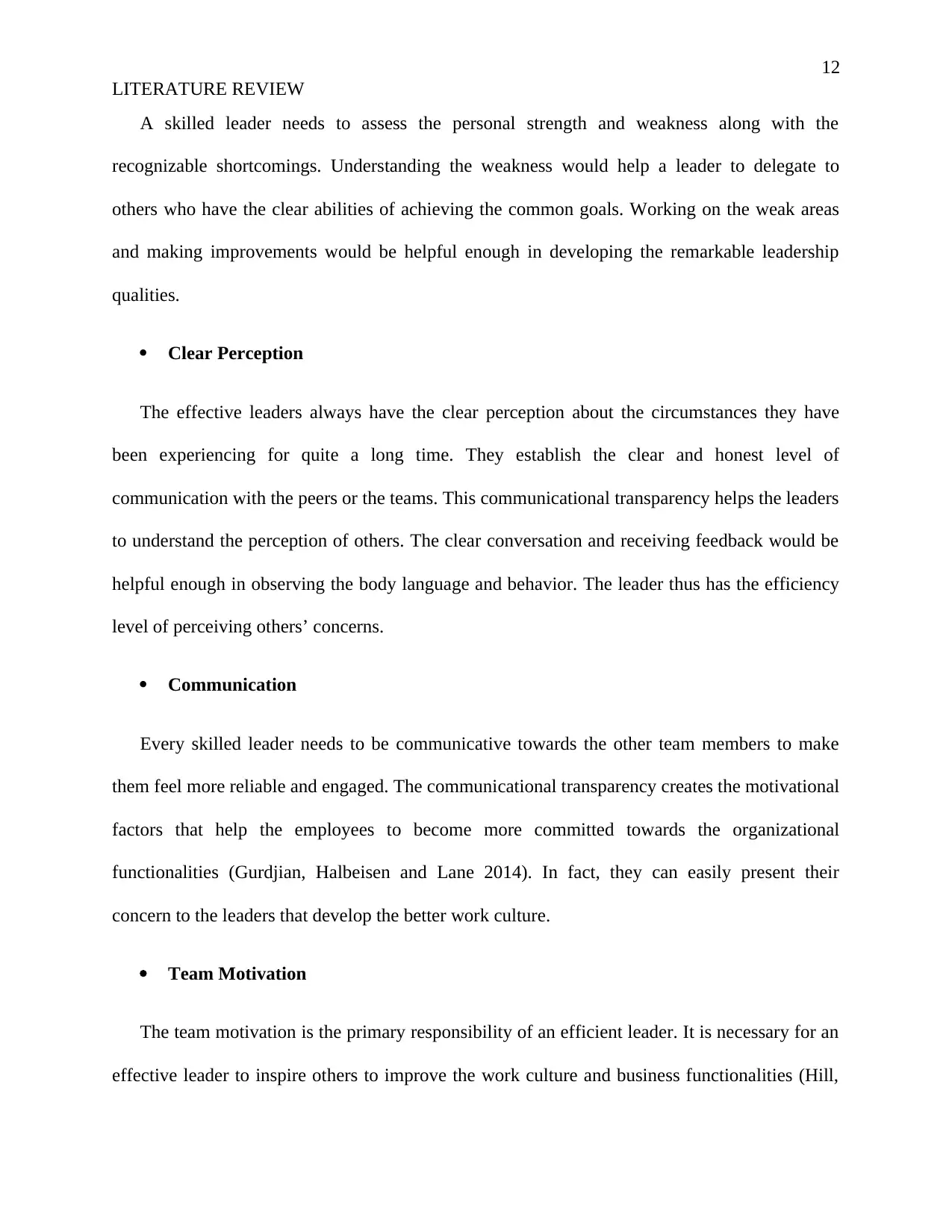
12
LITERATURE REVIEW
A skilled leader needs to assess the personal strength and weakness along with the
recognizable shortcomings. Understanding the weakness would help a leader to delegate to
others who have the clear abilities of achieving the common goals. Working on the weak areas
and making improvements would be helpful enough in developing the remarkable leadership
qualities.
Clear Perception
The effective leaders always have the clear perception about the circumstances they have
been experiencing for quite a long time. They establish the clear and honest level of
communication with the peers or the teams. This communicational transparency helps the leaders
to understand the perception of others. The clear conversation and receiving feedback would be
helpful enough in observing the body language and behavior. The leader thus has the efficiency
level of perceiving others’ concerns.
Communication
Every skilled leader needs to be communicative towards the other team members to make
them feel more reliable and engaged. The communicational transparency creates the motivational
factors that help the employees to become more committed towards the organizational
functionalities (Gurdjian, Halbeisen and Lane 2014). In fact, they can easily present their
concern to the leaders that develop the better work culture.
Team Motivation
The team motivation is the primary responsibility of an efficient leader. It is necessary for an
effective leader to inspire others to improve the work culture and business functionalities (Hill,
LITERATURE REVIEW
A skilled leader needs to assess the personal strength and weakness along with the
recognizable shortcomings. Understanding the weakness would help a leader to delegate to
others who have the clear abilities of achieving the common goals. Working on the weak areas
and making improvements would be helpful enough in developing the remarkable leadership
qualities.
Clear Perception
The effective leaders always have the clear perception about the circumstances they have
been experiencing for quite a long time. They establish the clear and honest level of
communication with the peers or the teams. This communicational transparency helps the leaders
to understand the perception of others. The clear conversation and receiving feedback would be
helpful enough in observing the body language and behavior. The leader thus has the efficiency
level of perceiving others’ concerns.
Communication
Every skilled leader needs to be communicative towards the other team members to make
them feel more reliable and engaged. The communicational transparency creates the motivational
factors that help the employees to become more committed towards the organizational
functionalities (Gurdjian, Halbeisen and Lane 2014). In fact, they can easily present their
concern to the leaders that develop the better work culture.
Team Motivation
The team motivation is the primary responsibility of an efficient leader. It is necessary for an
effective leader to inspire others to improve the work culture and business functionalities (Hill,
Secure Best Marks with AI Grader
Need help grading? Try our AI Grader for instant feedback on your assignments.
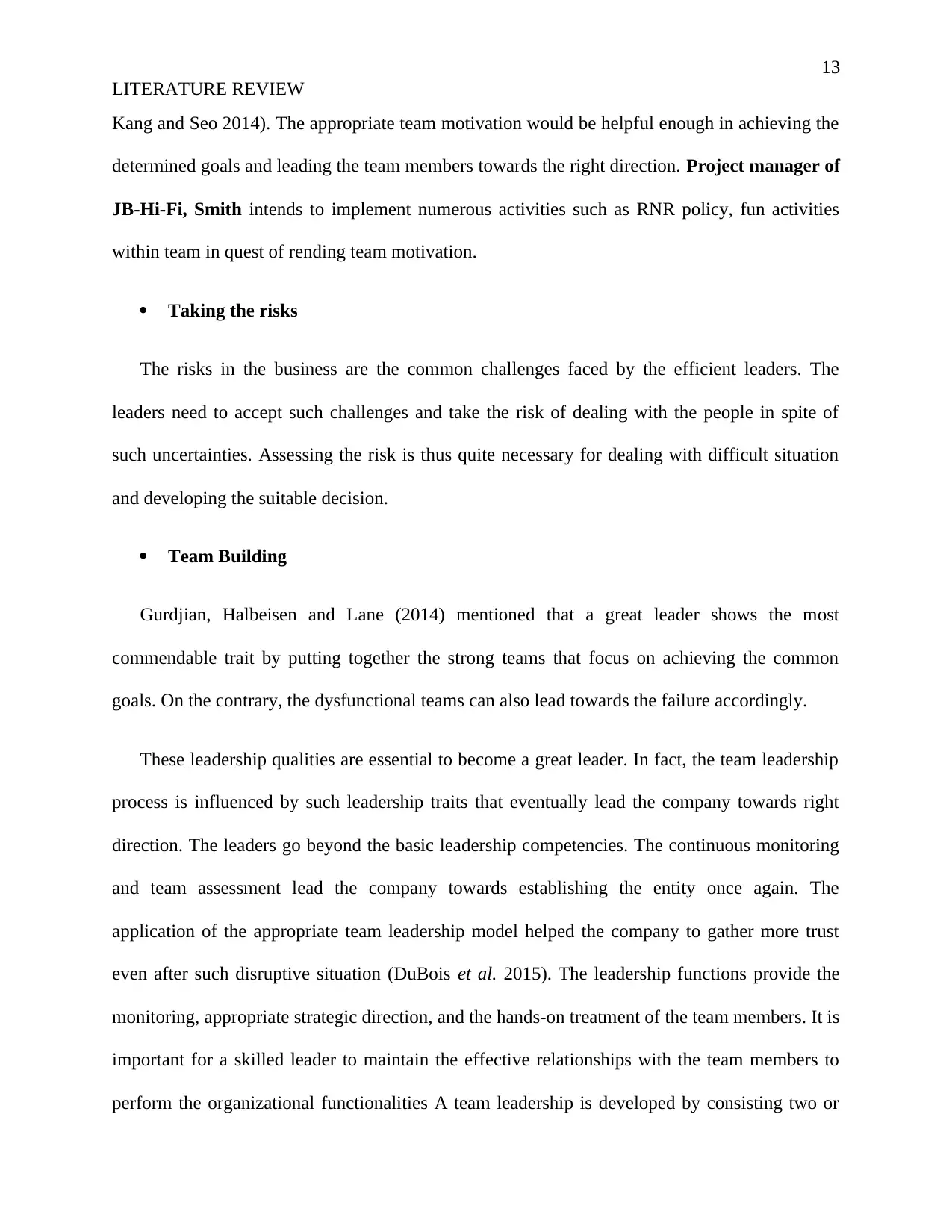
13
LITERATURE REVIEW
Kang and Seo 2014). The appropriate team motivation would be helpful enough in achieving the
determined goals and leading the team members towards the right direction. Project manager of
JB-Hi-Fi, Smith intends to implement numerous activities such as RNR policy, fun activities
within team in quest of rending team motivation.
Taking the risks
The risks in the business are the common challenges faced by the efficient leaders. The
leaders need to accept such challenges and take the risk of dealing with the people in spite of
such uncertainties. Assessing the risk is thus quite necessary for dealing with difficult situation
and developing the suitable decision.
Team Building
Gurdjian, Halbeisen and Lane (2014) mentioned that a great leader shows the most
commendable trait by putting together the strong teams that focus on achieving the common
goals. On the contrary, the dysfunctional teams can also lead towards the failure accordingly.
These leadership qualities are essential to become a great leader. In fact, the team leadership
process is influenced by such leadership traits that eventually lead the company towards right
direction. The leaders go beyond the basic leadership competencies. The continuous monitoring
and team assessment lead the company towards establishing the entity once again. The
application of the appropriate team leadership model helped the company to gather more trust
even after such disruptive situation (DuBois et al. 2015). The leadership functions provide the
monitoring, appropriate strategic direction, and the hands-on treatment of the team members. It is
important for a skilled leader to maintain the effective relationships with the team members to
perform the organizational functionalities A team leadership is developed by consisting two or
LITERATURE REVIEW
Kang and Seo 2014). The appropriate team motivation would be helpful enough in achieving the
determined goals and leading the team members towards the right direction. Project manager of
JB-Hi-Fi, Smith intends to implement numerous activities such as RNR policy, fun activities
within team in quest of rending team motivation.
Taking the risks
The risks in the business are the common challenges faced by the efficient leaders. The
leaders need to accept such challenges and take the risk of dealing with the people in spite of
such uncertainties. Assessing the risk is thus quite necessary for dealing with difficult situation
and developing the suitable decision.
Team Building
Gurdjian, Halbeisen and Lane (2014) mentioned that a great leader shows the most
commendable trait by putting together the strong teams that focus on achieving the common
goals. On the contrary, the dysfunctional teams can also lead towards the failure accordingly.
These leadership qualities are essential to become a great leader. In fact, the team leadership
process is influenced by such leadership traits that eventually lead the company towards right
direction. The leaders go beyond the basic leadership competencies. The continuous monitoring
and team assessment lead the company towards establishing the entity once again. The
application of the appropriate team leadership model helped the company to gather more trust
even after such disruptive situation (DuBois et al. 2015). The leadership functions provide the
monitoring, appropriate strategic direction, and the hands-on treatment of the team members. It is
important for a skilled leader to maintain the effective relationships with the team members to
perform the organizational functionalities A team leadership is developed by consisting two or
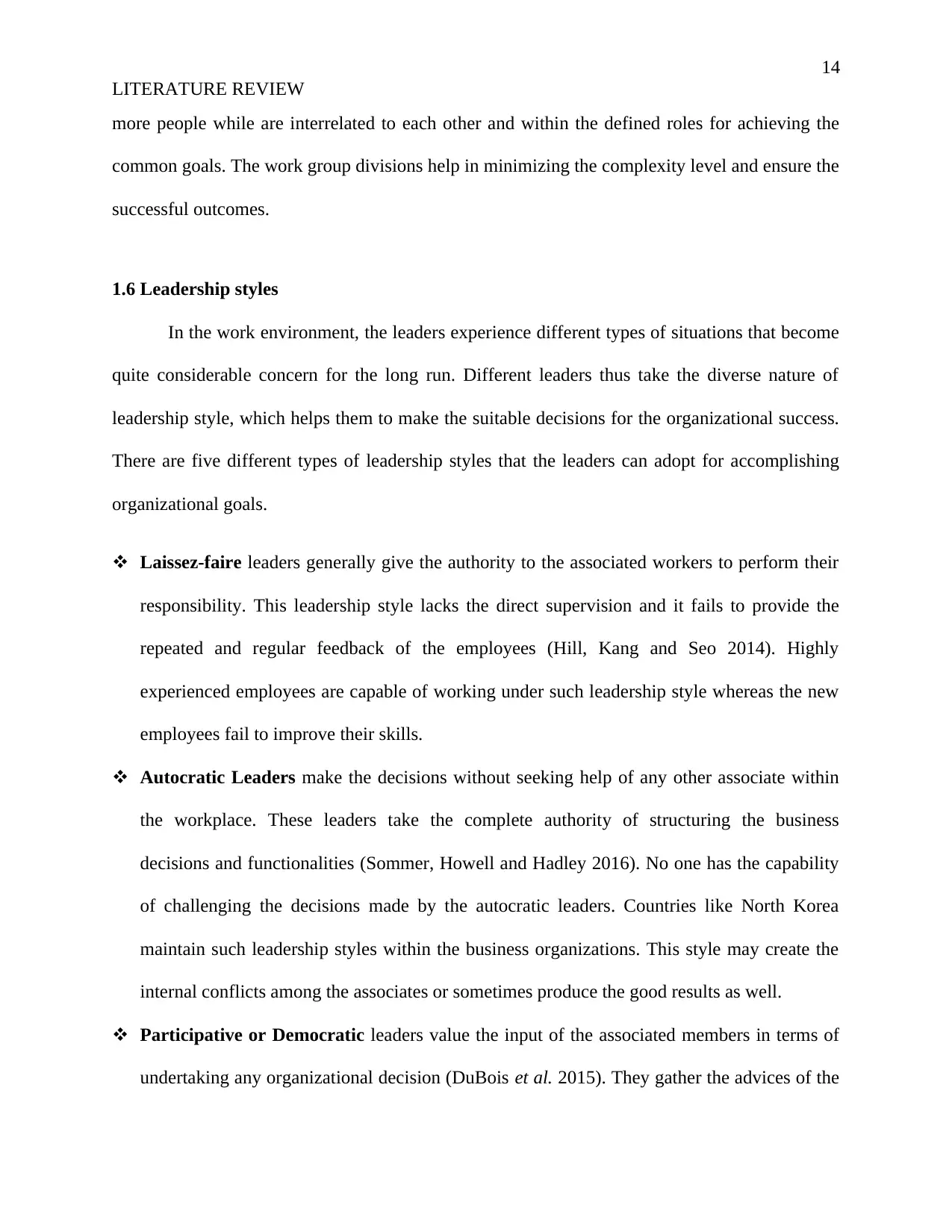
14
LITERATURE REVIEW
more people while are interrelated to each other and within the defined roles for achieving the
common goals. The work group divisions help in minimizing the complexity level and ensure the
successful outcomes.
1.6 Leadership styles
In the work environment, the leaders experience different types of situations that become
quite considerable concern for the long run. Different leaders thus take the diverse nature of
leadership style, which helps them to make the suitable decisions for the organizational success.
There are five different types of leadership styles that the leaders can adopt for accomplishing
organizational goals.
Laissez-faire leaders generally give the authority to the associated workers to perform their
responsibility. This leadership style lacks the direct supervision and it fails to provide the
repeated and regular feedback of the employees (Hill, Kang and Seo 2014). Highly
experienced employees are capable of working under such leadership style whereas the new
employees fail to improve their skills.
Autocratic Leaders make the decisions without seeking help of any other associate within
the workplace. These leaders take the complete authority of structuring the business
decisions and functionalities (Sommer, Howell and Hadley 2016). No one has the capability
of challenging the decisions made by the autocratic leaders. Countries like North Korea
maintain such leadership styles within the business organizations. This style may create the
internal conflicts among the associates or sometimes produce the good results as well.
Participative or Democratic leaders value the input of the associated members in terms of
undertaking any organizational decision (DuBois et al. 2015). They gather the advices of the
LITERATURE REVIEW
more people while are interrelated to each other and within the defined roles for achieving the
common goals. The work group divisions help in minimizing the complexity level and ensure the
successful outcomes.
1.6 Leadership styles
In the work environment, the leaders experience different types of situations that become
quite considerable concern for the long run. Different leaders thus take the diverse nature of
leadership style, which helps them to make the suitable decisions for the organizational success.
There are five different types of leadership styles that the leaders can adopt for accomplishing
organizational goals.
Laissez-faire leaders generally give the authority to the associated workers to perform their
responsibility. This leadership style lacks the direct supervision and it fails to provide the
repeated and regular feedback of the employees (Hill, Kang and Seo 2014). Highly
experienced employees are capable of working under such leadership style whereas the new
employees fail to improve their skills.
Autocratic Leaders make the decisions without seeking help of any other associate within
the workplace. These leaders take the complete authority of structuring the business
decisions and functionalities (Sommer, Howell and Hadley 2016). No one has the capability
of challenging the decisions made by the autocratic leaders. Countries like North Korea
maintain such leadership styles within the business organizations. This style may create the
internal conflicts among the associates or sometimes produce the good results as well.
Participative or Democratic leaders value the input of the associated members in terms of
undertaking any organizational decision (DuBois et al. 2015). They gather the advices of the
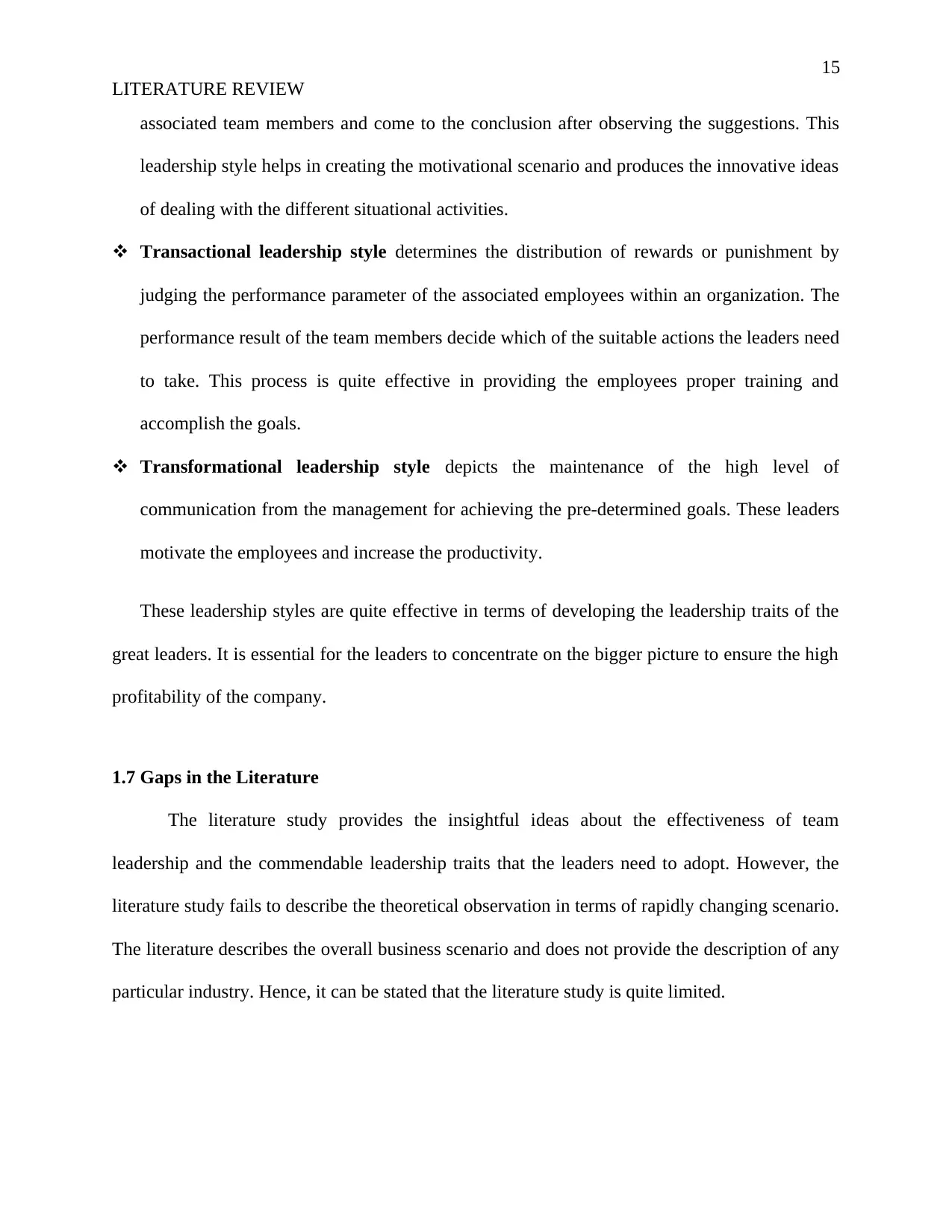
15
LITERATURE REVIEW
associated team members and come to the conclusion after observing the suggestions. This
leadership style helps in creating the motivational scenario and produces the innovative ideas
of dealing with the different situational activities.
Transactional leadership style determines the distribution of rewards or punishment by
judging the performance parameter of the associated employees within an organization. The
performance result of the team members decide which of the suitable actions the leaders need
to take. This process is quite effective in providing the employees proper training and
accomplish the goals.
Transformational leadership style depicts the maintenance of the high level of
communication from the management for achieving the pre-determined goals. These leaders
motivate the employees and increase the productivity.
These leadership styles are quite effective in terms of developing the leadership traits of the
great leaders. It is essential for the leaders to concentrate on the bigger picture to ensure the high
profitability of the company.
1.7 Gaps in the Literature
The literature study provides the insightful ideas about the effectiveness of team
leadership and the commendable leadership traits that the leaders need to adopt. However, the
literature study fails to describe the theoretical observation in terms of rapidly changing scenario.
The literature describes the overall business scenario and does not provide the description of any
particular industry. Hence, it can be stated that the literature study is quite limited.
LITERATURE REVIEW
associated team members and come to the conclusion after observing the suggestions. This
leadership style helps in creating the motivational scenario and produces the innovative ideas
of dealing with the different situational activities.
Transactional leadership style determines the distribution of rewards or punishment by
judging the performance parameter of the associated employees within an organization. The
performance result of the team members decide which of the suitable actions the leaders need
to take. This process is quite effective in providing the employees proper training and
accomplish the goals.
Transformational leadership style depicts the maintenance of the high level of
communication from the management for achieving the pre-determined goals. These leaders
motivate the employees and increase the productivity.
These leadership styles are quite effective in terms of developing the leadership traits of the
great leaders. It is essential for the leaders to concentrate on the bigger picture to ensure the high
profitability of the company.
1.7 Gaps in the Literature
The literature study provides the insightful ideas about the effectiveness of team
leadership and the commendable leadership traits that the leaders need to adopt. However, the
literature study fails to describe the theoretical observation in terms of rapidly changing scenario.
The literature describes the overall business scenario and does not provide the description of any
particular industry. Hence, it can be stated that the literature study is quite limited.
Paraphrase This Document
Need a fresh take? Get an instant paraphrase of this document with our AI Paraphraser
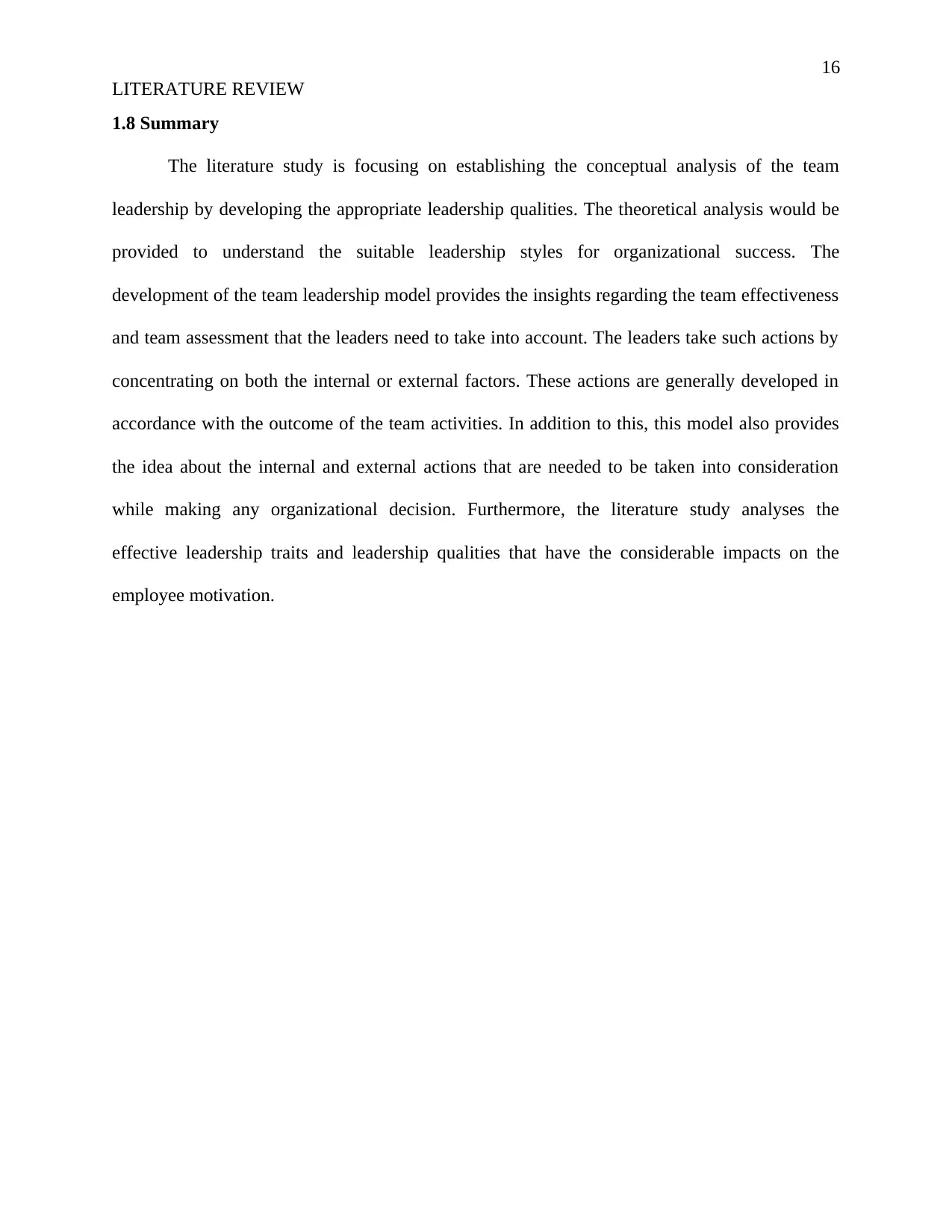
16
LITERATURE REVIEW
1.8 Summary
The literature study is focusing on establishing the conceptual analysis of the team
leadership by developing the appropriate leadership qualities. The theoretical analysis would be
provided to understand the suitable leadership styles for organizational success. The
development of the team leadership model provides the insights regarding the team effectiveness
and team assessment that the leaders need to take into account. The leaders take such actions by
concentrating on both the internal or external factors. These actions are generally developed in
accordance with the outcome of the team activities. In addition to this, this model also provides
the idea about the internal and external actions that are needed to be taken into consideration
while making any organizational decision. Furthermore, the literature study analyses the
effective leadership traits and leadership qualities that have the considerable impacts on the
employee motivation.
LITERATURE REVIEW
1.8 Summary
The literature study is focusing on establishing the conceptual analysis of the team
leadership by developing the appropriate leadership qualities. The theoretical analysis would be
provided to understand the suitable leadership styles for organizational success. The
development of the team leadership model provides the insights regarding the team effectiveness
and team assessment that the leaders need to take into account. The leaders take such actions by
concentrating on both the internal or external factors. These actions are generally developed in
accordance with the outcome of the team activities. In addition to this, this model also provides
the idea about the internal and external actions that are needed to be taken into consideration
while making any organizational decision. Furthermore, the literature study analyses the
effective leadership traits and leadership qualities that have the considerable impacts on the
employee motivation.

17
LITERATURE REVIEW
References
Alavi, S.B. and McCormick, J., 2016. Implications of proxy efficacy for studies of team
leadership in organizational settings. European Psychologist.
Anderson, M.H. and Sun, P.Y., 2017. Reviewing leadership styles: Overlaps and the need for a
new ‘full‐range’theory. International Journal of Management Reviews, 19(1), pp.76-96.
Cederblom, T., 2014. Strengthening a team leadership approach to the multi-site church model.
Assemblies of God Theological Seminary.
Certo, S., 2015. Supervision: Concepts and skill-building. McGraw-Hill Higher Education.
Chen, W., McCollum, M., Bradley, E. and Chen, D.T., 2016. Shared team leadership training
through pre‐clerkship team‐based learning. Medical education, 50(11), pp.1148-1149.
D’Innocenzo, L., Mathieu, J.E. and Kukenberger, M.R., 2016. A meta-analysis of different forms
of shared leadership–team performance relations. Journal of Management, 42(7), pp.1964-1991.
Dabke, D., 2016. Impact of leader’s emotional intelligence and transformational behavior on
perceived leadership effectiveness: A multiple source view. Business Perspectives and
Research, 4(1), pp.27-40.
Day, D.V., Fleenor, J.W., Atwater, L.E., Sturm, R.E. and McKee, R.A., 2014. Advances in
leader and leadership development: A review of 25years of research and theory. The Leadership
Quarterly, 25(1), pp.63-82.
LITERATURE REVIEW
References
Alavi, S.B. and McCormick, J., 2016. Implications of proxy efficacy for studies of team
leadership in organizational settings. European Psychologist.
Anderson, M.H. and Sun, P.Y., 2017. Reviewing leadership styles: Overlaps and the need for a
new ‘full‐range’theory. International Journal of Management Reviews, 19(1), pp.76-96.
Cederblom, T., 2014. Strengthening a team leadership approach to the multi-site church model.
Assemblies of God Theological Seminary.
Certo, S., 2015. Supervision: Concepts and skill-building. McGraw-Hill Higher Education.
Chen, W., McCollum, M., Bradley, E. and Chen, D.T., 2016. Shared team leadership training
through pre‐clerkship team‐based learning. Medical education, 50(11), pp.1148-1149.
D’Innocenzo, L., Mathieu, J.E. and Kukenberger, M.R., 2016. A meta-analysis of different forms
of shared leadership–team performance relations. Journal of Management, 42(7), pp.1964-1991.
Dabke, D., 2016. Impact of leader’s emotional intelligence and transformational behavior on
perceived leadership effectiveness: A multiple source view. Business Perspectives and
Research, 4(1), pp.27-40.
Day, D.V., Fleenor, J.W., Atwater, L.E., Sturm, R.E. and McKee, R.A., 2014. Advances in
leader and leadership development: A review of 25years of research and theory. The Leadership
Quarterly, 25(1), pp.63-82.
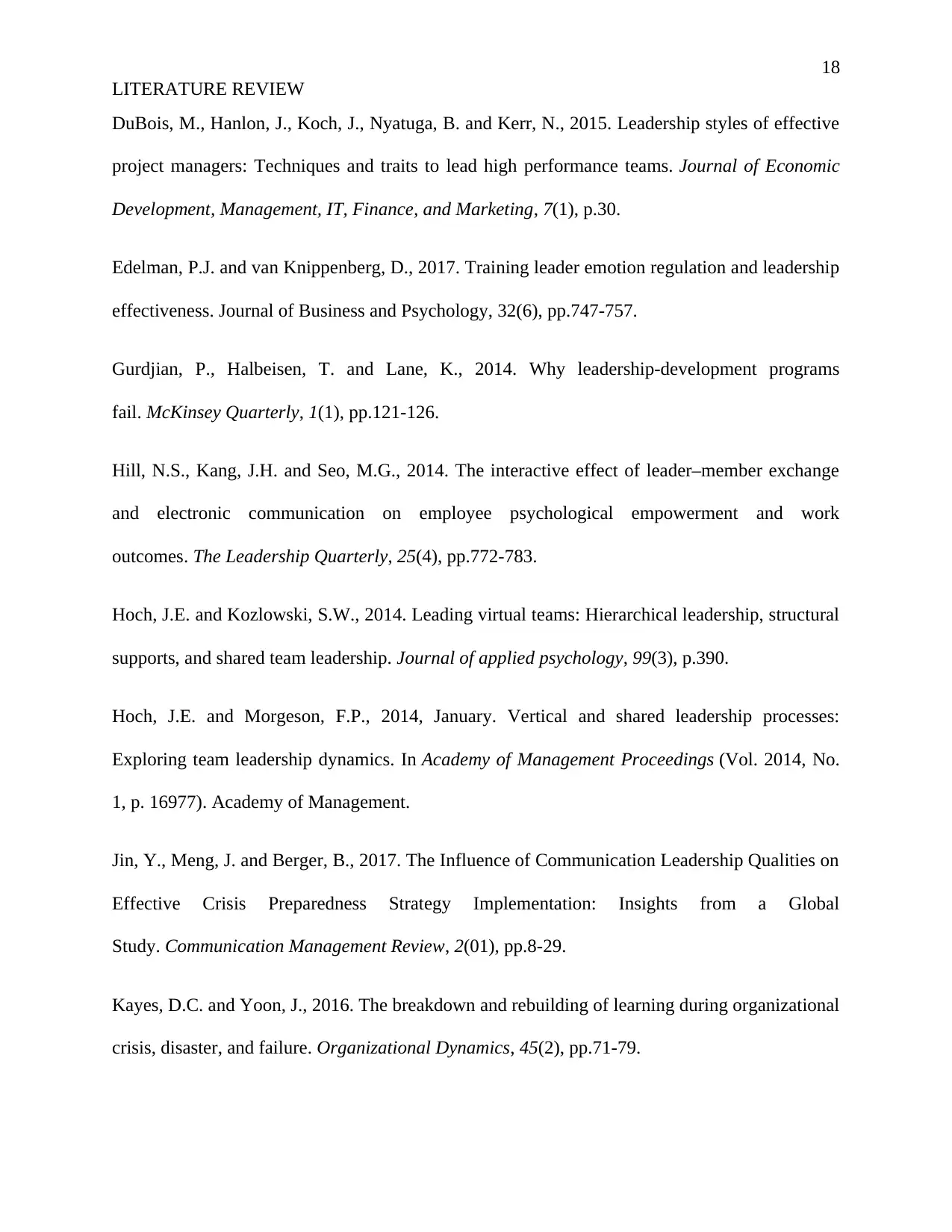
18
LITERATURE REVIEW
DuBois, M., Hanlon, J., Koch, J., Nyatuga, B. and Kerr, N., 2015. Leadership styles of effective
project managers: Techniques and traits to lead high performance teams. Journal of Economic
Development, Management, IT, Finance, and Marketing, 7(1), p.30.
Edelman, P.J. and van Knippenberg, D., 2017. Training leader emotion regulation and leadership
effectiveness. Journal of Business and Psychology, 32(6), pp.747-757.
Gurdjian, P., Halbeisen, T. and Lane, K., 2014. Why leadership-development programs
fail. McKinsey Quarterly, 1(1), pp.121-126.
Hill, N.S., Kang, J.H. and Seo, M.G., 2014. The interactive effect of leader–member exchange
and electronic communication on employee psychological empowerment and work
outcomes. The Leadership Quarterly, 25(4), pp.772-783.
Hoch, J.E. and Kozlowski, S.W., 2014. Leading virtual teams: Hierarchical leadership, structural
supports, and shared team leadership. Journal of applied psychology, 99(3), p.390.
Hoch, J.E. and Morgeson, F.P., 2014, January. Vertical and shared leadership processes:
Exploring team leadership dynamics. In Academy of Management Proceedings (Vol. 2014, No.
1, p. 16977). Academy of Management.
Jin, Y., Meng, J. and Berger, B., 2017. The Influence of Communication Leadership Qualities on
Effective Crisis Preparedness Strategy Implementation: Insights from a Global
Study. Communication Management Review, 2(01), pp.8-29.
Kayes, D.C. and Yoon, J., 2016. The breakdown and rebuilding of learning during organizational
crisis, disaster, and failure. Organizational Dynamics, 45(2), pp.71-79.
LITERATURE REVIEW
DuBois, M., Hanlon, J., Koch, J., Nyatuga, B. and Kerr, N., 2015. Leadership styles of effective
project managers: Techniques and traits to lead high performance teams. Journal of Economic
Development, Management, IT, Finance, and Marketing, 7(1), p.30.
Edelman, P.J. and van Knippenberg, D., 2017. Training leader emotion regulation and leadership
effectiveness. Journal of Business and Psychology, 32(6), pp.747-757.
Gurdjian, P., Halbeisen, T. and Lane, K., 2014. Why leadership-development programs
fail. McKinsey Quarterly, 1(1), pp.121-126.
Hill, N.S., Kang, J.H. and Seo, M.G., 2014. The interactive effect of leader–member exchange
and electronic communication on employee psychological empowerment and work
outcomes. The Leadership Quarterly, 25(4), pp.772-783.
Hoch, J.E. and Kozlowski, S.W., 2014. Leading virtual teams: Hierarchical leadership, structural
supports, and shared team leadership. Journal of applied psychology, 99(3), p.390.
Hoch, J.E. and Morgeson, F.P., 2014, January. Vertical and shared leadership processes:
Exploring team leadership dynamics. In Academy of Management Proceedings (Vol. 2014, No.
1, p. 16977). Academy of Management.
Jin, Y., Meng, J. and Berger, B., 2017. The Influence of Communication Leadership Qualities on
Effective Crisis Preparedness Strategy Implementation: Insights from a Global
Study. Communication Management Review, 2(01), pp.8-29.
Kayes, D.C. and Yoon, J., 2016. The breakdown and rebuilding of learning during organizational
crisis, disaster, and failure. Organizational Dynamics, 45(2), pp.71-79.
Secure Best Marks with AI Grader
Need help grading? Try our AI Grader for instant feedback on your assignments.
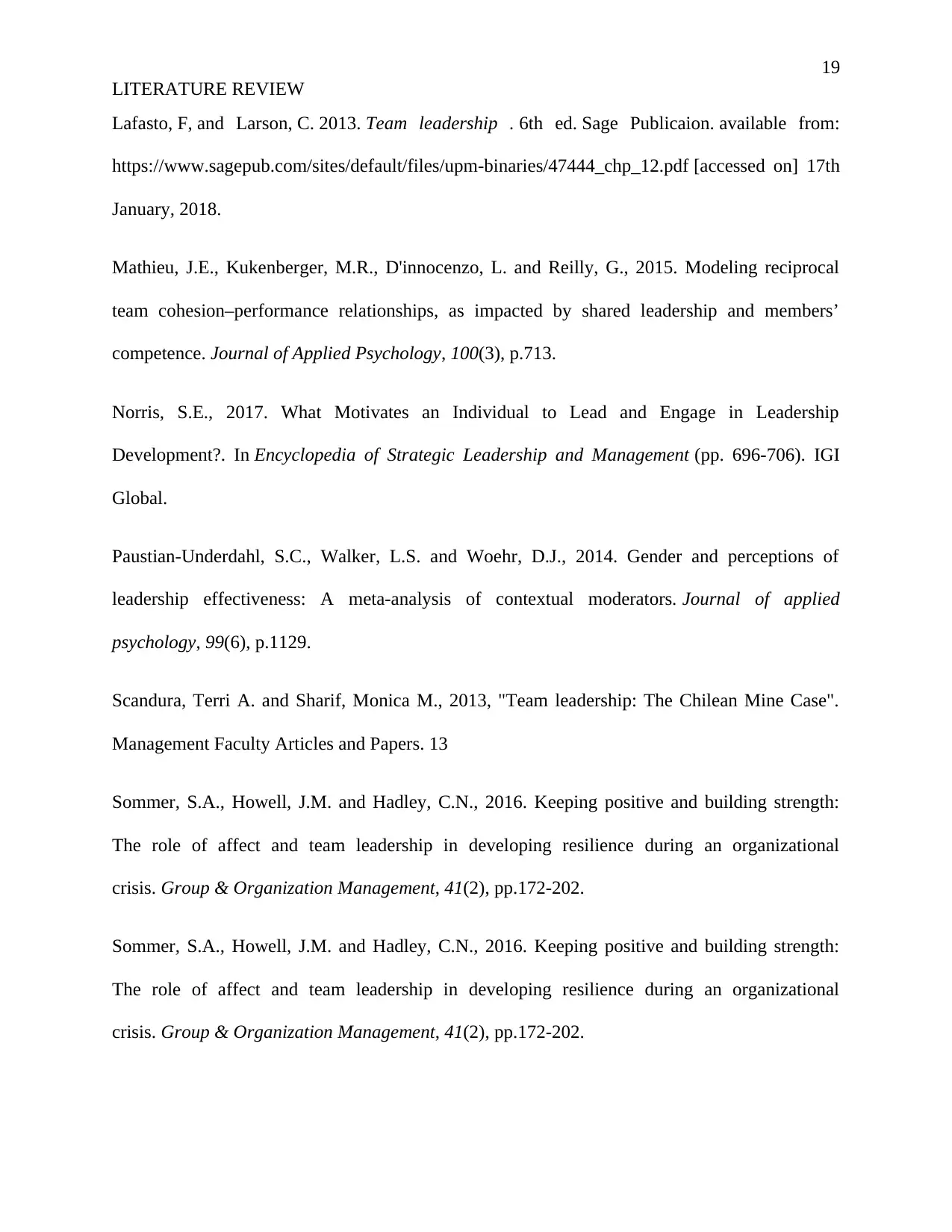
19
LITERATURE REVIEW
Lafasto, F, and Larson, C. 2013. Team leadership . 6th ed. Sage Publicaion. available from:
https://www.sagepub.com/sites/default/files/upm-binaries/47444_chp_12.pdf [accessed on] 17th
January, 2018.
Mathieu, J.E., Kukenberger, M.R., D'innocenzo, L. and Reilly, G., 2015. Modeling reciprocal
team cohesion–performance relationships, as impacted by shared leadership and members’
competence. Journal of Applied Psychology, 100(3), p.713.
Norris, S.E., 2017. What Motivates an Individual to Lead and Engage in Leadership
Development?. In Encyclopedia of Strategic Leadership and Management (pp. 696-706). IGI
Global.
Paustian-Underdahl, S.C., Walker, L.S. and Woehr, D.J., 2014. Gender and perceptions of
leadership effectiveness: A meta-analysis of contextual moderators. Journal of applied
psychology, 99(6), p.1129.
Scandura, Terri A. and Sharif, Monica M., 2013, "Team leadership: The Chilean Mine Case".
Management Faculty Articles and Papers. 13
Sommer, S.A., Howell, J.M. and Hadley, C.N., 2016. Keeping positive and building strength:
The role of affect and team leadership in developing resilience during an organizational
crisis. Group & Organization Management, 41(2), pp.172-202.
Sommer, S.A., Howell, J.M. and Hadley, C.N., 2016. Keeping positive and building strength:
The role of affect and team leadership in developing resilience during an organizational
crisis. Group & Organization Management, 41(2), pp.172-202.
LITERATURE REVIEW
Lafasto, F, and Larson, C. 2013. Team leadership . 6th ed. Sage Publicaion. available from:
https://www.sagepub.com/sites/default/files/upm-binaries/47444_chp_12.pdf [accessed on] 17th
January, 2018.
Mathieu, J.E., Kukenberger, M.R., D'innocenzo, L. and Reilly, G., 2015. Modeling reciprocal
team cohesion–performance relationships, as impacted by shared leadership and members’
competence. Journal of Applied Psychology, 100(3), p.713.
Norris, S.E., 2017. What Motivates an Individual to Lead and Engage in Leadership
Development?. In Encyclopedia of Strategic Leadership and Management (pp. 696-706). IGI
Global.
Paustian-Underdahl, S.C., Walker, L.S. and Woehr, D.J., 2014. Gender and perceptions of
leadership effectiveness: A meta-analysis of contextual moderators. Journal of applied
psychology, 99(6), p.1129.
Scandura, Terri A. and Sharif, Monica M., 2013, "Team leadership: The Chilean Mine Case".
Management Faculty Articles and Papers. 13
Sommer, S.A., Howell, J.M. and Hadley, C.N., 2016. Keeping positive and building strength:
The role of affect and team leadership in developing resilience during an organizational
crisis. Group & Organization Management, 41(2), pp.172-202.
Sommer, S.A., Howell, J.M. and Hadley, C.N., 2016. Keeping positive and building strength:
The role of affect and team leadership in developing resilience during an organizational
crisis. Group & Organization Management, 41(2), pp.172-202.
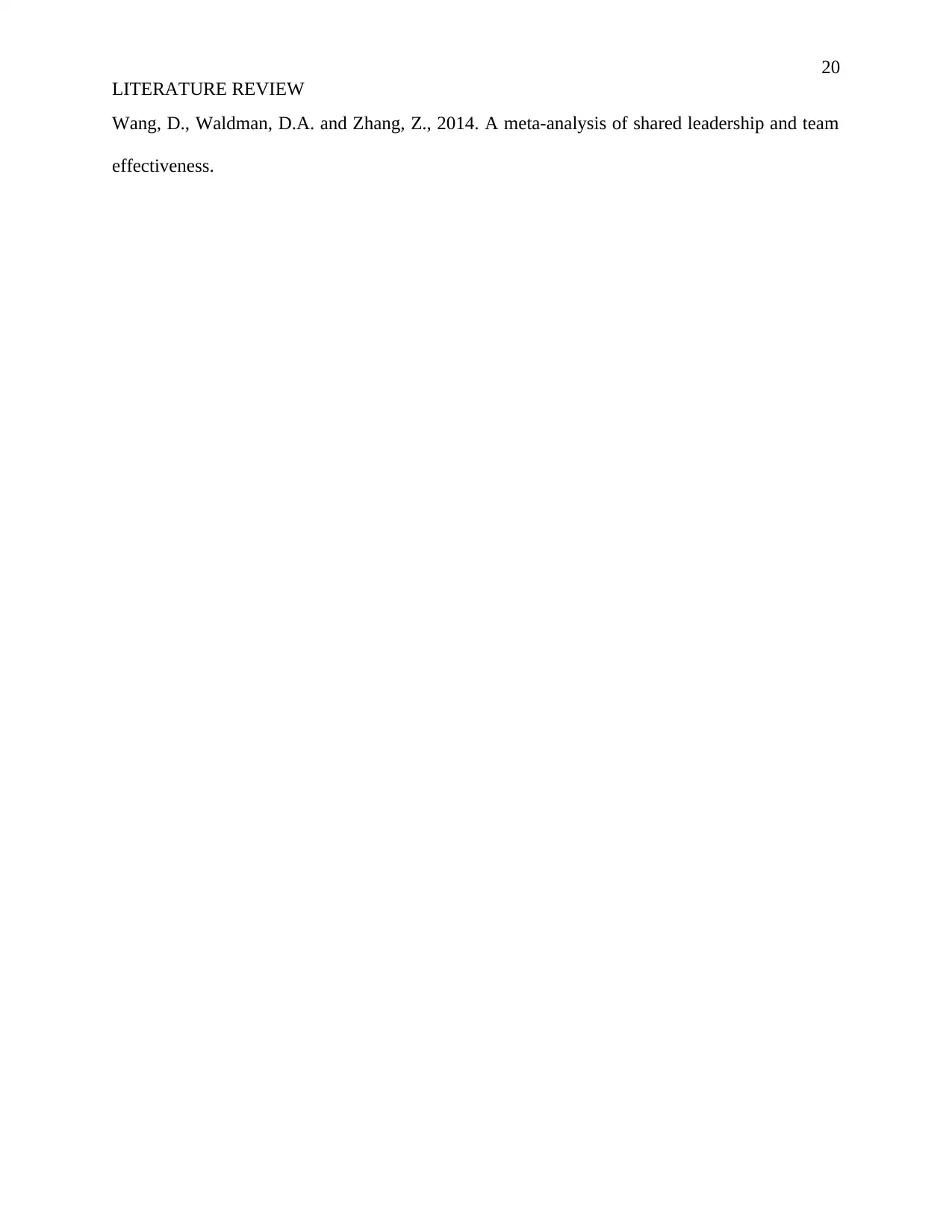
20
LITERATURE REVIEW
Wang, D., Waldman, D.A. and Zhang, Z., 2014. A meta-analysis of shared leadership and team
effectiveness.
LITERATURE REVIEW
Wang, D., Waldman, D.A. and Zhang, Z., 2014. A meta-analysis of shared leadership and team
effectiveness.
1 out of 21
Related Documents
Your All-in-One AI-Powered Toolkit for Academic Success.
+13062052269
info@desklib.com
Available 24*7 on WhatsApp / Email
![[object Object]](/_next/static/media/star-bottom.7253800d.svg)
Unlock your academic potential
© 2024 | Zucol Services PVT LTD | All rights reserved.





